The Gisclard Bridges,
precursors of the large stayed girder bridges
Michel Wagner
![]()
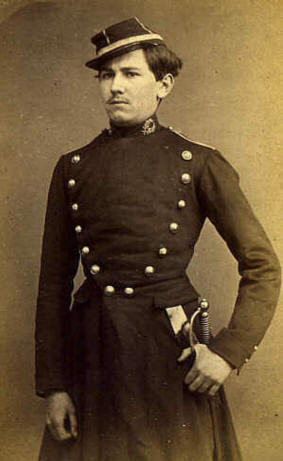 Albert
Gisclard was born in Nimes in 1844. ll is difficult to find documents
concerning its biography, apart from polytechnician at 20 years, it
engages in military Engineering where he will become commander.
Albert
Gisclard was born in Nimes in 1844. ll is difficult to find documents
concerning its biography, apart from polytechnician at 20 years, it
engages in military Engineering where he will become commander.
Here he studies and conceives many types of bridges, likely to quickly
replace works destroyed at the time of conflict : " While during the war
of 1870-71, the repair of a bridge for railway always required about
thirty days, one can ensure that the material which we have will make it
possible to conclude same work in less than thirty hours... "
(bulletin of Arts and Trades of 1890)
Document from the Ecole Polytechnique( S.ce P.Cazenove)
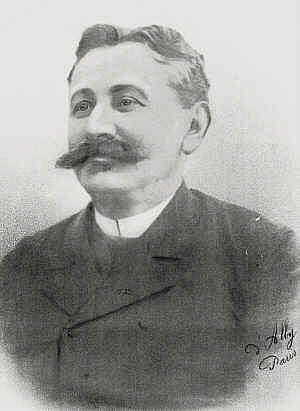
Photo
used as a model for
the memorial stone (sculptor
Jean André
Rixens)
Coll.Catherine Gisclard
![]()
Gateway Profile
suspended military
imagined by the
commander Gisclard
( from the revue"La Nature" n° 908 du 25 octobre 1890)
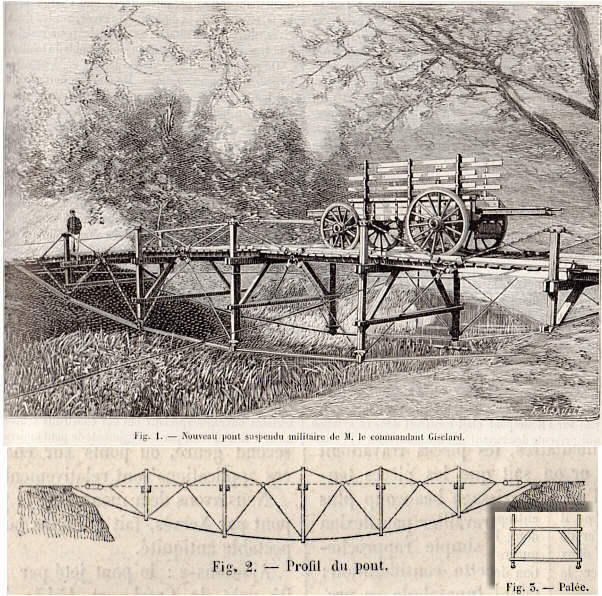
Postcard
from 1906
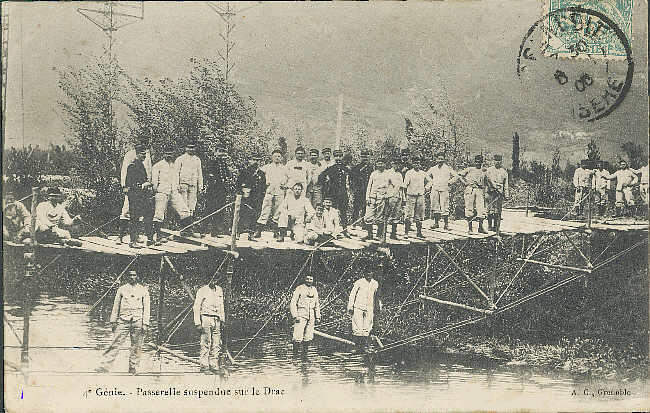
Since 1897, it continues its research in the
private one and in 1900 it
deposits a patent of suspension bridge allowing the passage of loads
much heavier than on the traditionalsuspension bridges invented and
built by Marc Seguin, then improved by Ferdinand Arnodin
The cables are laid out there in a quite particular and more complex way; parts of smelting works are placed at their ends and their intersections, to form an indeformable system of triangles and polygons which can be calculated starting from the rules of statics and which confer on the unit the great rigidity which was missing with the suspension bridges of average and great range
In order to be able to test the feasibility and the system
effectiveness, it gives the licence of exclusive construction of it to
the company Arnodin de Châteauneuf and it is Gaston Leinekugel Cocq
which is charged to supervise the construction of the first bridges of
the Gisclard type, four bridges of
average related in high Ogooué in Congo, of 1902 to 1907,
and a footbridge to New Caledonia,
the Marguerite footbridge at La Foa.
Photo
of a bridge of Haut-Ogoue in the course of assembly in Ets Arnodin (
coll.D.Leinekugel LeCocq)
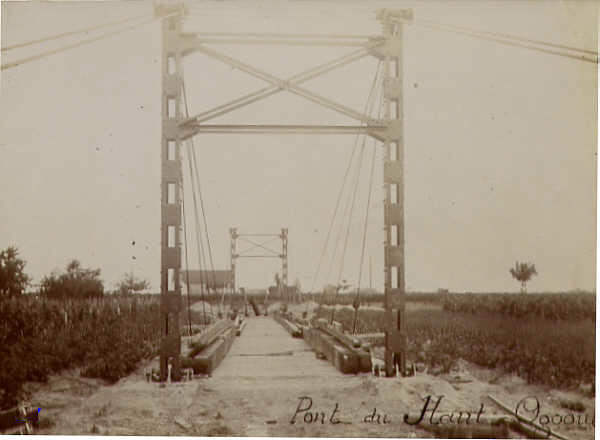
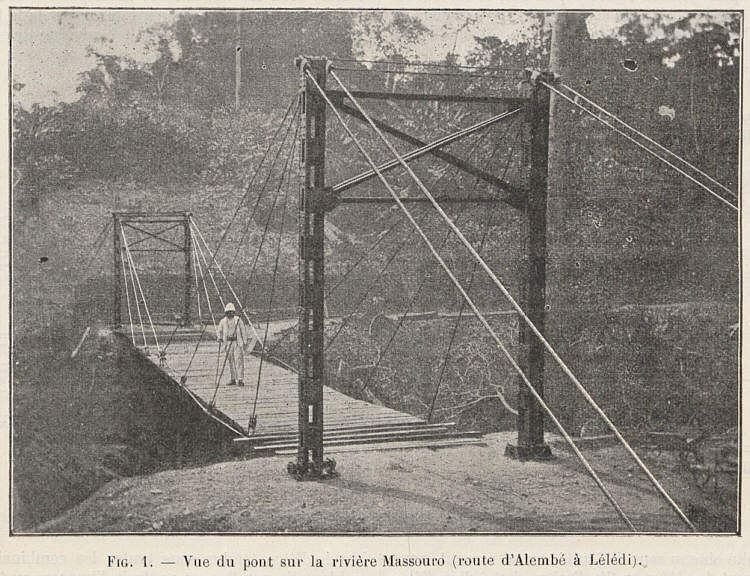
Bridging a bridge in the Châteauneuf surLoire
workshops -Cliché Arnodin - Coll
D.Chenot
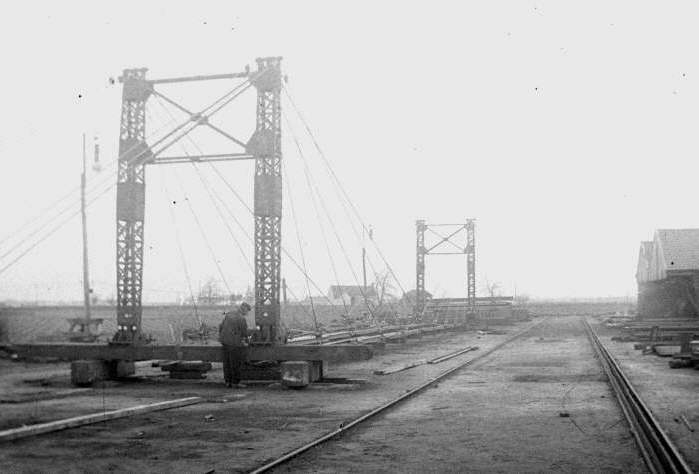
Excerpt from the magazine "Le Génie Civil" of 27
August 1904 and plans of the bridge over the Massouro river
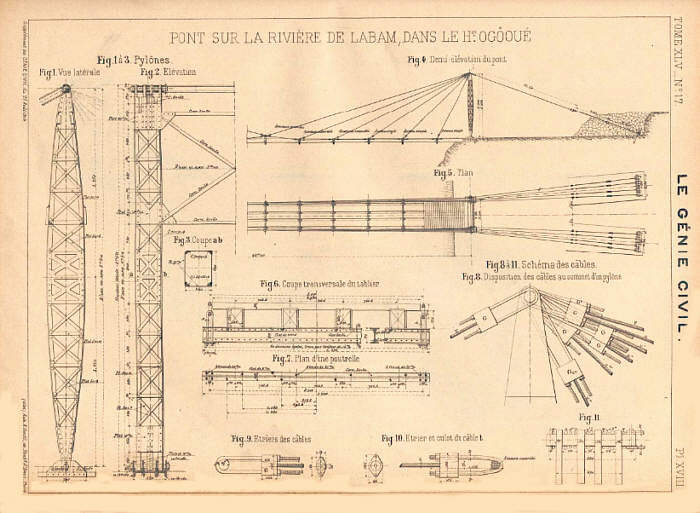
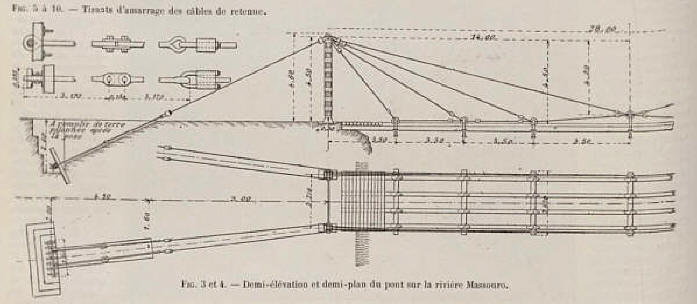
Bridge built c.
1910 in the " Haut Ogooue" (Africa) -
Postcard written
in 1931 (coll.MW)
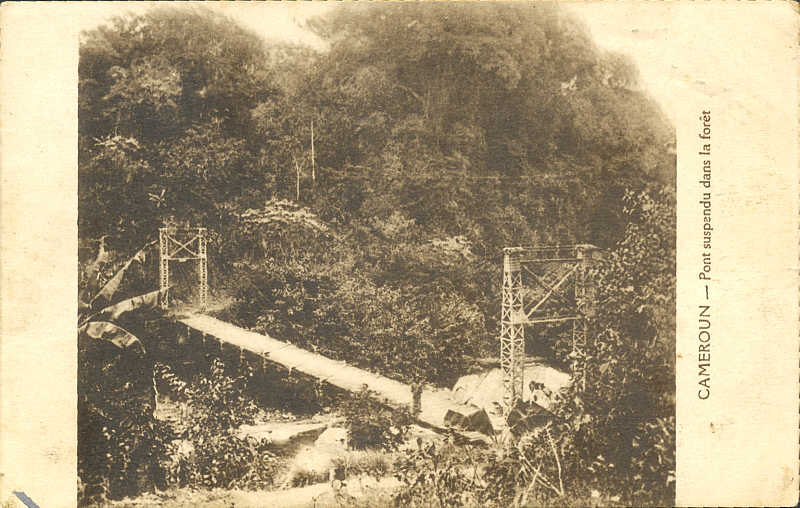
The Bridge of La Foa
in New Caledonia
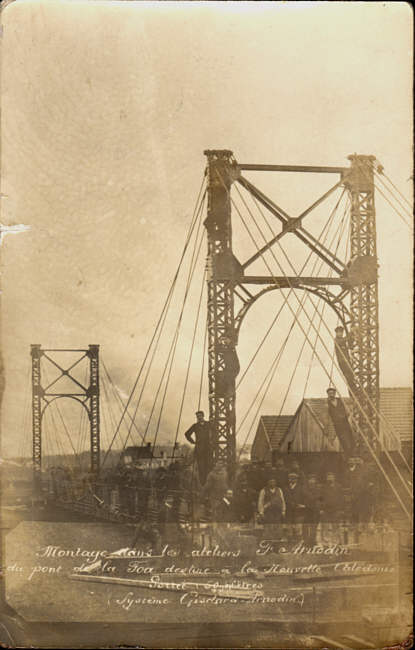 This bridge was built en1909
to replace a wood bridge become obsolete. The choice was made on
a metal suspension bridge which was to allow the passage of the cars, a
bridge of the Gisclard type under licence of Arnodin construction was
selected. Built, checked to the factories of the Châteauneuf-on-Loire,
it then was transported, assembled then inaugurated on June 25, 1909.
This bridge was built en1909
to replace a wood bridge become obsolete. The choice was made on
a metal suspension bridge which was to allow the passage of the cars, a
bridge of the Gisclard type under licence of Arnodin construction was
selected. Built, checked to the factories of the Châteauneuf-on-Loire,
it then was transported, assembled then inaugurated on June 25, 1909.
Assembly in the Arnodin workshops of the La Foa bridge in New Caledonia.
Range 50 meters - (Gisclard-Arnodin System) "
Postcard
sent in December 1908
Its name, the" Marguerite footbridge" comes from the first name of the
wife of the governor of New Caledonia, Marguerite Richard who cut the
ribbon at the time of this inauguration. Length of 48m for a chaussee of
3m broad, it could support automobile overloads of 4t on two axles, Of
the work of reinforcement completed into 1927 increased this load to 10
T..)
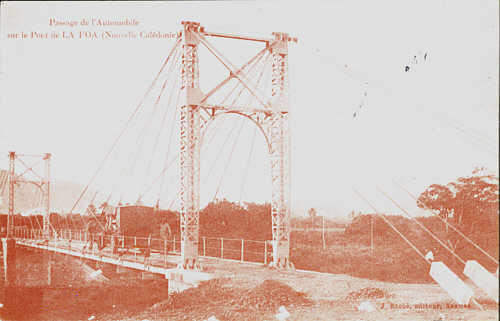 Old Postcard
(Coll. M.W
Old Postcard
(Coll. M.W
Very worn out by weather and elements, and a new bridge in concrete
having been put in service in 1989 to assure a traffic become
problematic, the footbridge is threatened.
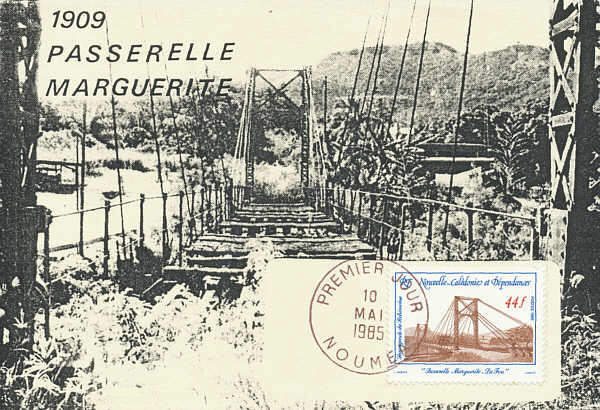
After its classification the 13 rd november1984, in the inventory of
historic monuments, the Municipality and the Association Marguerite
mobilize to protect it.
A stamp is issued in 1985,
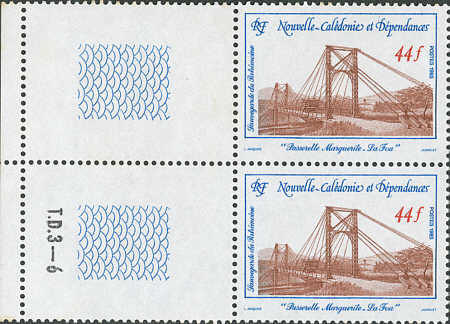
Timbre de 1985 et épreuve de luxe
Stamp from
1985 and official engraving(Coll.
M.W.)
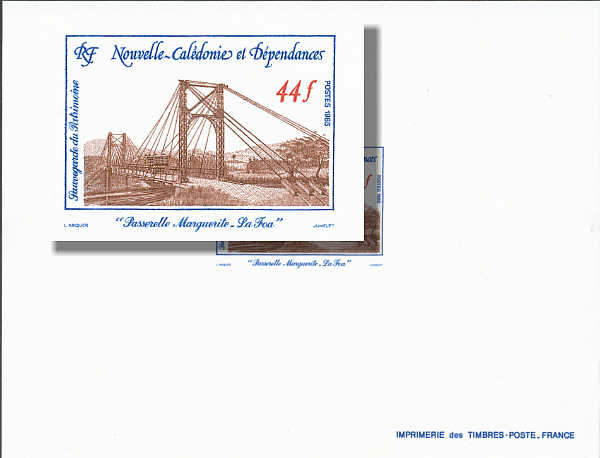
Old postcard-
J. Rache Ed. Nouméa
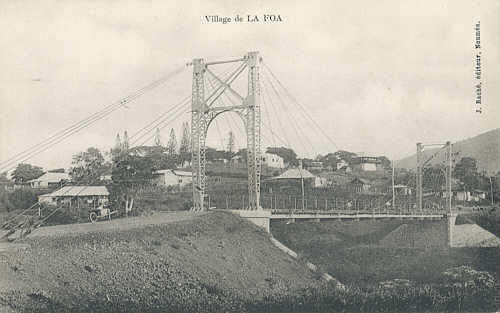
Postcard fdc
(Coll. M.W.)
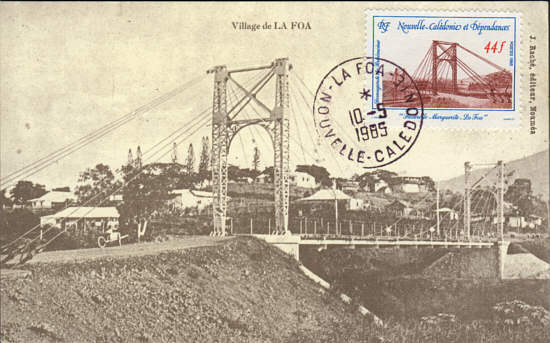
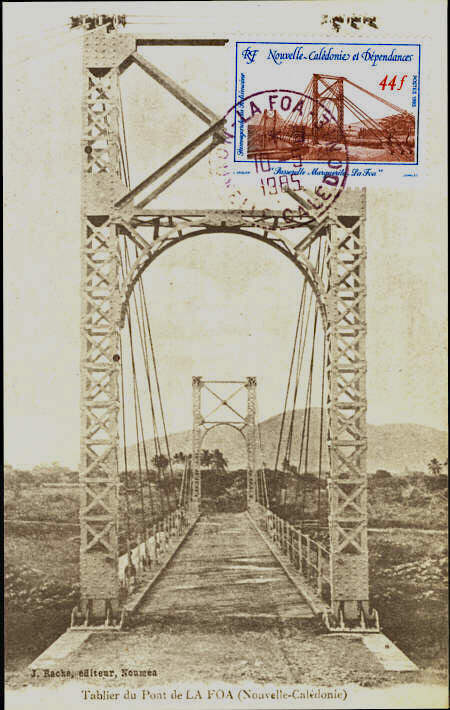
First day covers( Coll. M.W.)
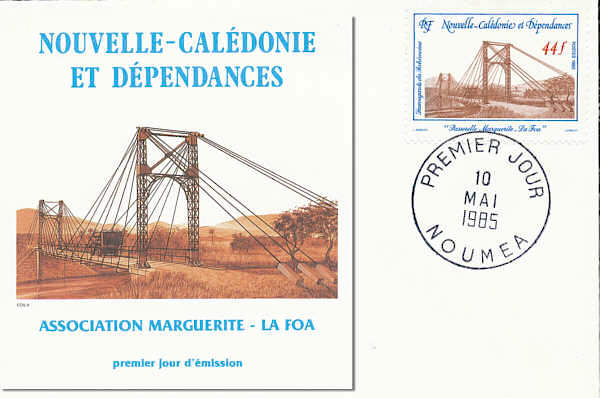
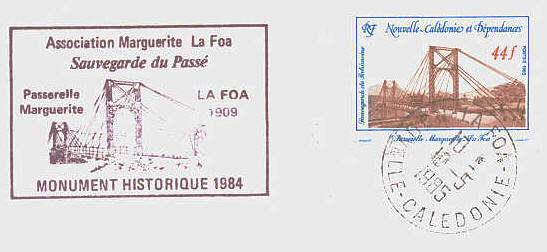
Fdc( Coll. M.W.)
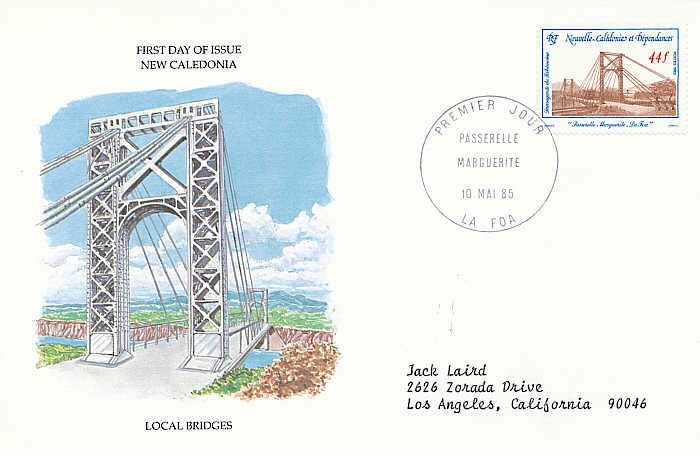
The footpath
become a real visual emblem for the municipality, it is repaired and
used from 1997 in pedestrian and tourist purposes.
Postal stationary
2003
(Coll. M.W.)
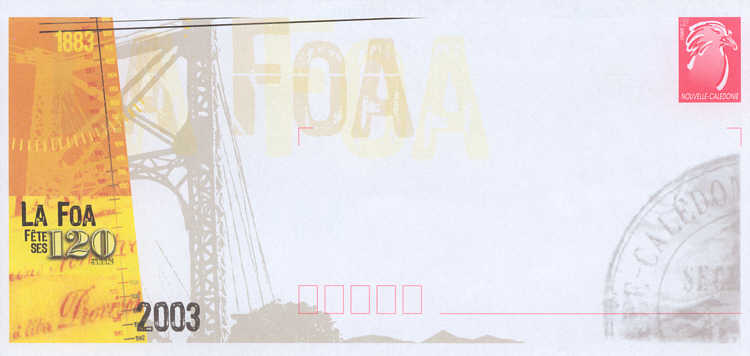
Following the recent photo
Collection Association
Marguerite, with kind
permission
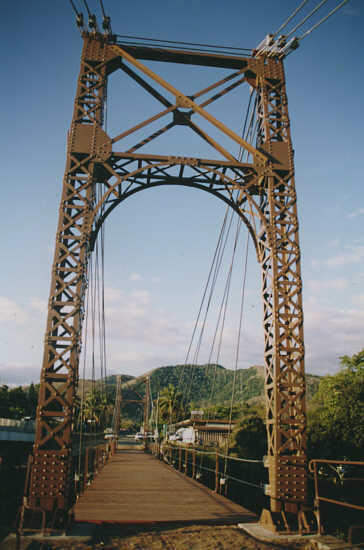
Postmark from 2002
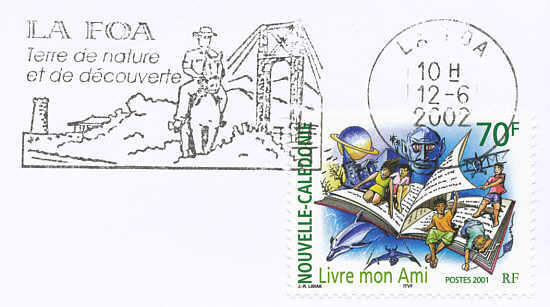
A film festival is organized every year in
La Foa, the image of the bridgeis used there in a recurring way:
Stamp from 2009

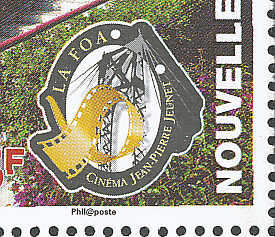
Covers from 2009

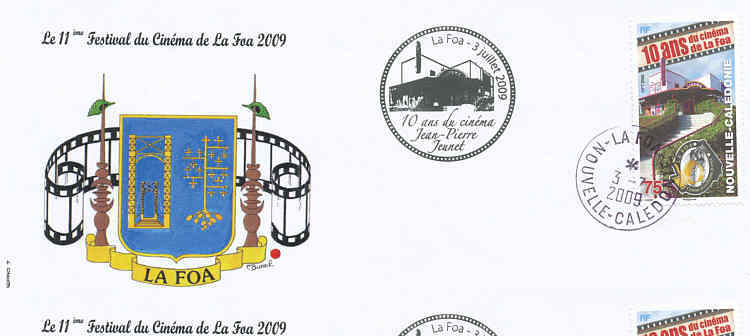
Postal stationary from 2010
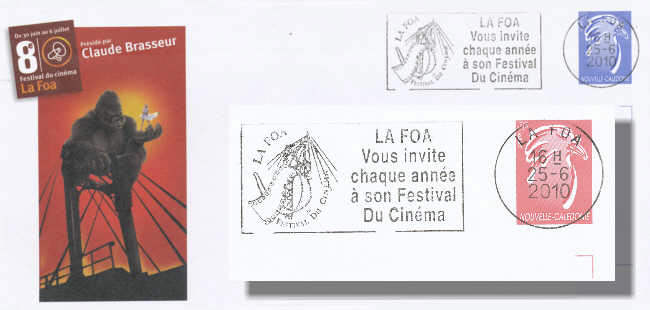
1910, the masterpiece of Albert Gisclard : the bridge of La Cassagne
The establishment of a railway line electric
(
the famous Yellow Train), intended to cross Cerdagne, having been
taken, and the project of line declared of public utility in 1903,
Arnodin associated with Gisclard were required for the construction of a
rigid suspension bridge on a section of the line connecting
Villefranche-de-Conflent to Bourg-Madame.
Modern postcard
(Coll. M.W.)
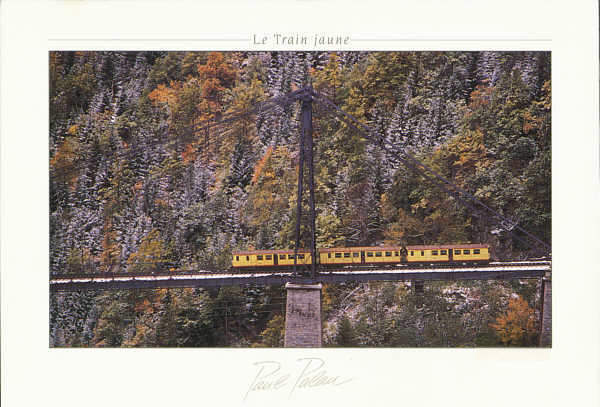
It was the ideal occasion to conclude an
ambitious technical project drawn by Gisclard into 1896 which made it
possible to apply its cabling system to works of long range and to carry
out the first suspension bridge for railroad.
Postal
stationery of 1981 published by the Railwaymen Philatelists
(Coll. M.W.)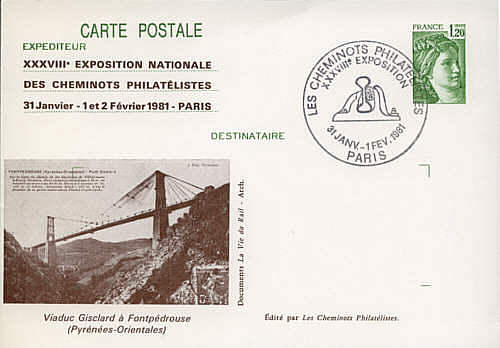
Postal stationery
from 2004 (Coll. M.W.)
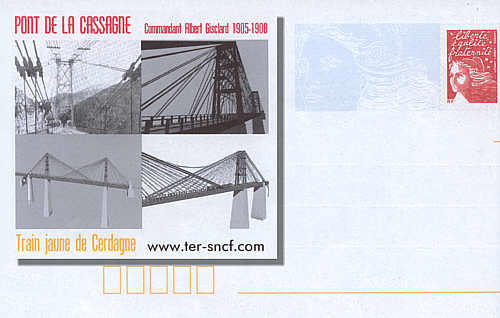
This 873 tons and
253 m length metal bridge crosses the river Têt 80 m in height at an
altitude of 1300m. It is supported by the pylons of two piles in masonry
of 28 and 32 m high, separated by a distance from 151 m. The cables are
manufactured according to the process with alternate torsion imagined by
Arnodin.
The alternating twist cable, document and photo of a
sample - (collMW)
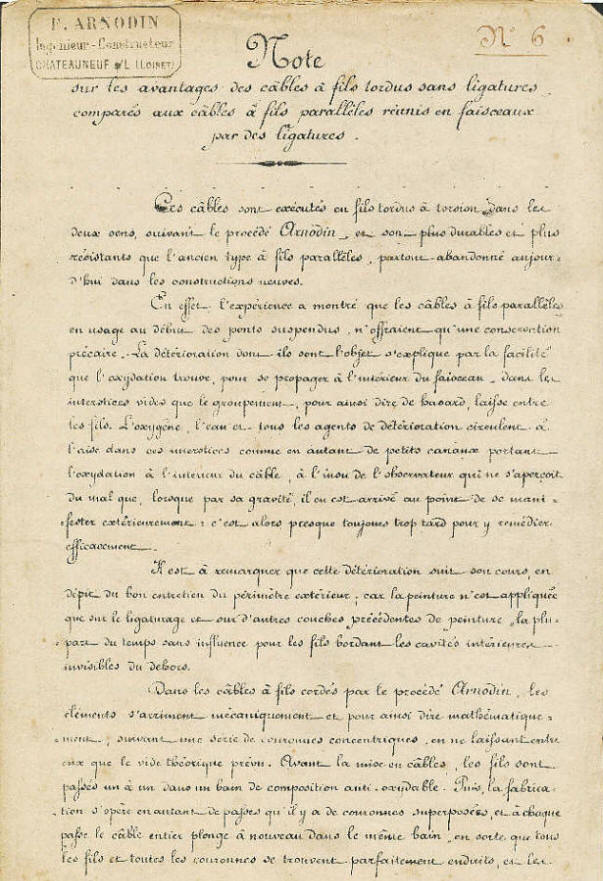

Elévation ,
Annales des Ponts & Chaussées -1913
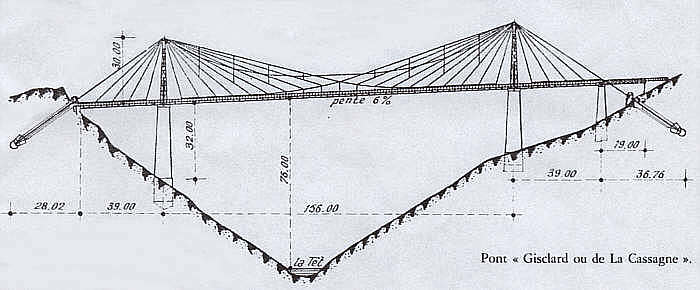
Building of the Bridge
Utilisation of the "Riveuse Arnodin"- (Clinching engine)
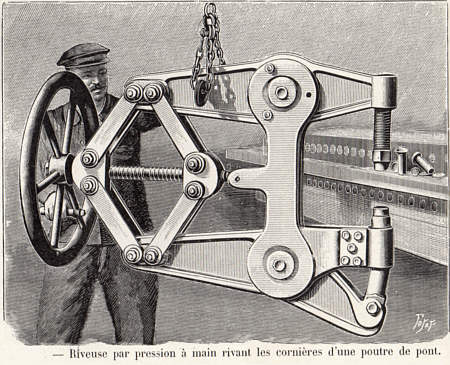
Setting up a pylon and setting up the deck (
( Revue le Génie civil n°1393 de
février 1909)
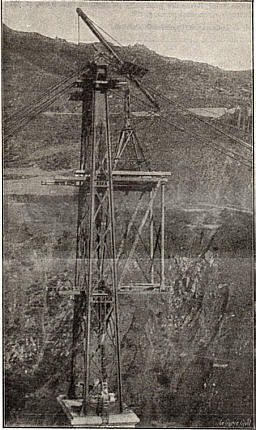
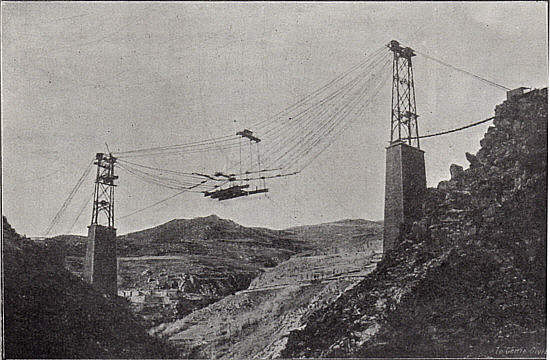
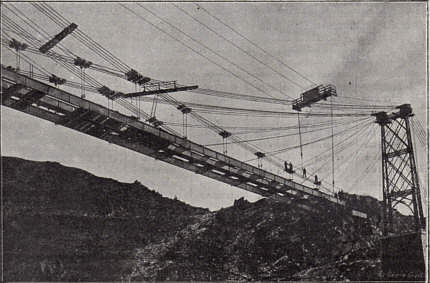
1908 -
Building the bride...Poscard sent on 1913
(Coll. M.W.)
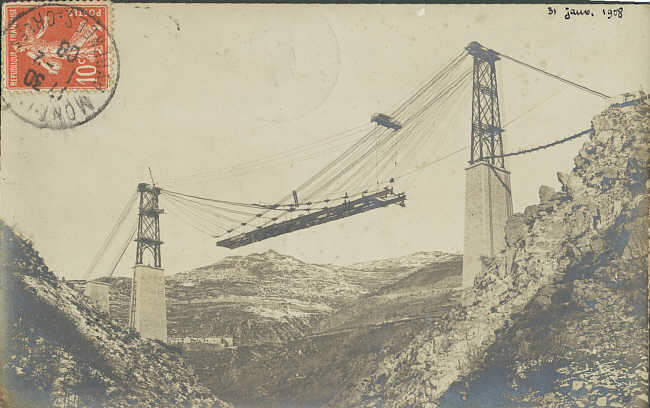
Building of the bridge -
Photos on glass plates from the Arnodin Fund,
(coll D.Chénot)
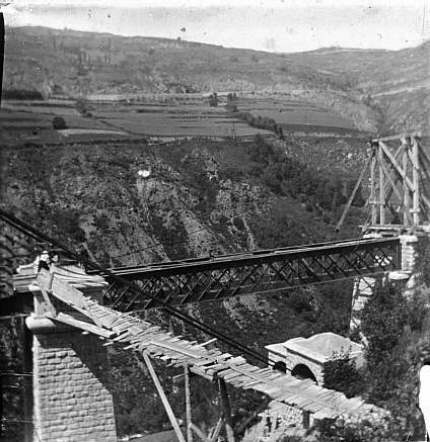
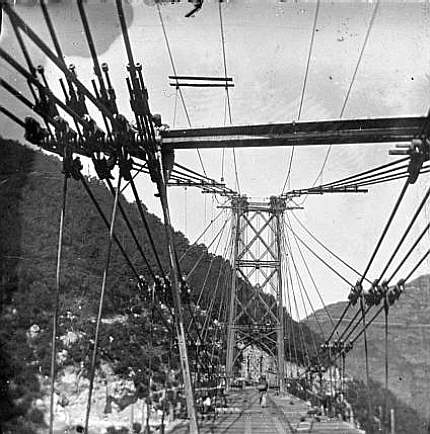
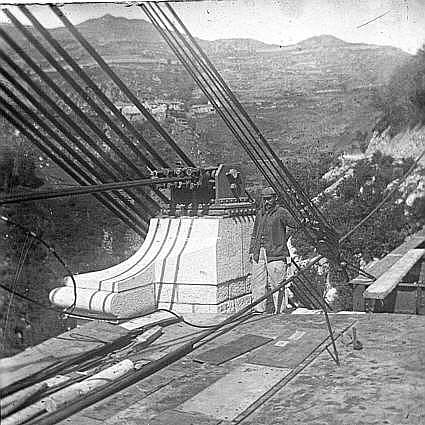
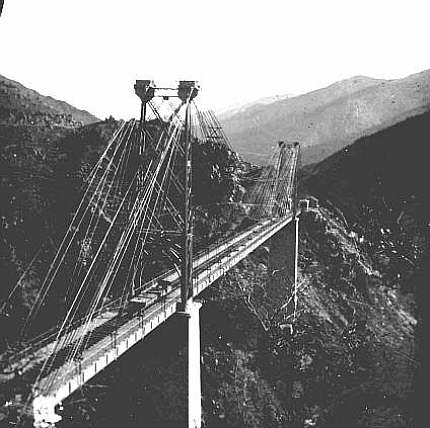
Construction of the bridge - postcard
sent in 1913 and repro with cancel
(Coll. M.W.)
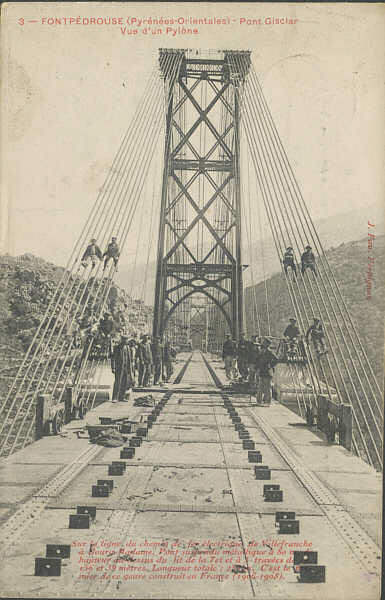
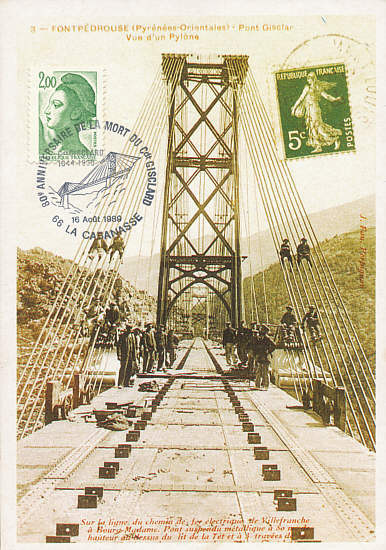
The construction of
this bridge has been very oddly, pictured on a non official stamp from
Somalia, issued in 2003,
showing...an old british vapor engine !!...(Coll.
M.W.)

Cover of a magazine, October 1928
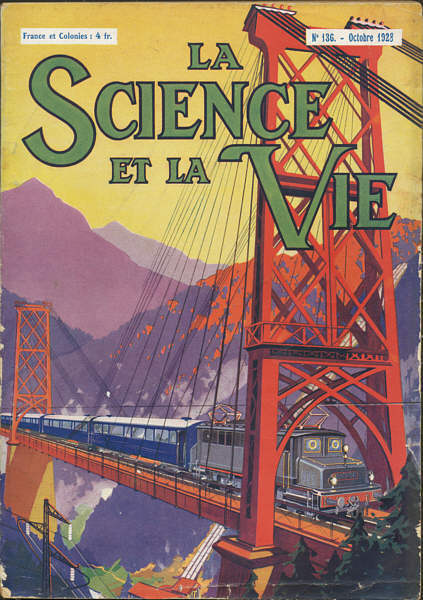
Old postcards
(Coll. M.W.)
ND Photo 1913
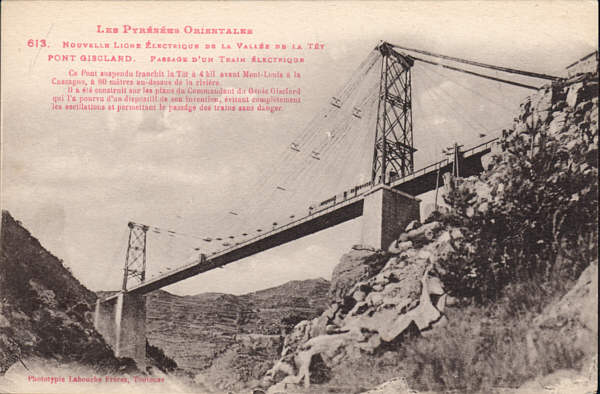
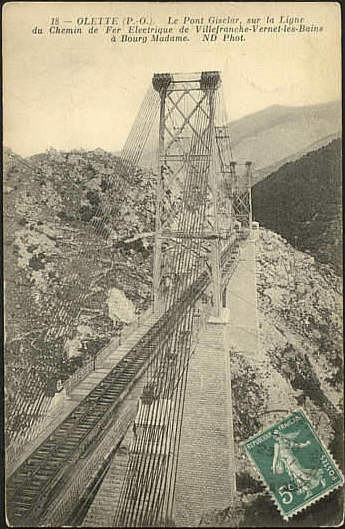
Ed Labouche
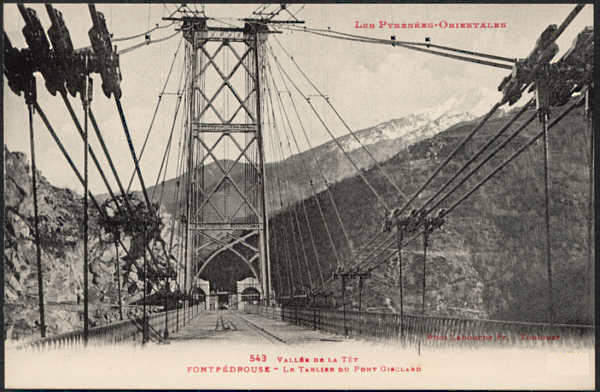
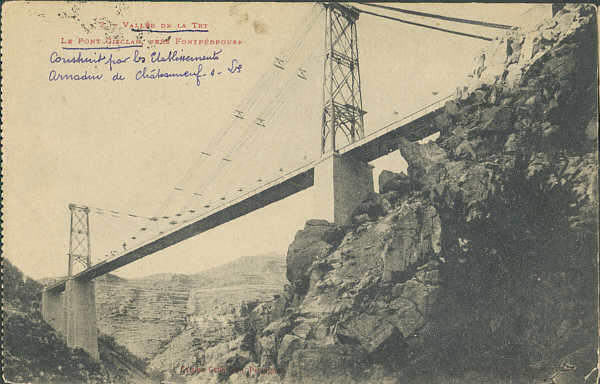
The building site will last three years and will be carried out under
painful conditions but its success, perfect on the technological level,
will end in a true drama on October 31, 1909 at the time of the tests of
load and stability of the bridge.
The catastrophe of the Paillat and the death of the Commander Gisclard.
The Paillat'
Viaduct, old postcard
Ed J .Fau 1910
(coll.
M.W.)
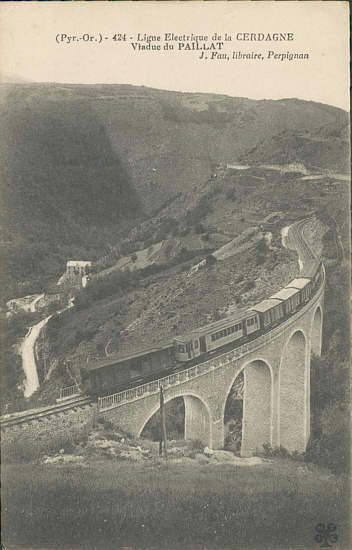
The official tests began on october 19, 1909. Sunday October 31, 1909, a heavy convoy made up of several railcars and several flat cars heavily charged with rails was used for the last tests. After having crossed without problem the bridge, it was stopped and divided into two for a last passage, to go up towards Mount-Louis, the other to go down again the slope. On its board about fifteen people, workmen and engineers; the driver having noted a pressure drop in the compressed-air circuit of the brakes, starts the engine intended to fill the compressor; the workmen believing then at the beginning withdraw the holds without awaiting the order of startup, and in spite of the blocked brakes, the heavy convoy shakes, slips more and more quickly on the slope and runs off the line in a curve downwards, with the locality of Paillat. Six people are killed, of which the commander Gisclard and Jules Bezault, foreman of Arnodin, and director of work. Ferdinand Arnodin and Gaston Leinekugel Le Cocq are wounded with 7 other people...
old poscard Ed J .Fau 1910
(coll.
M.W.)
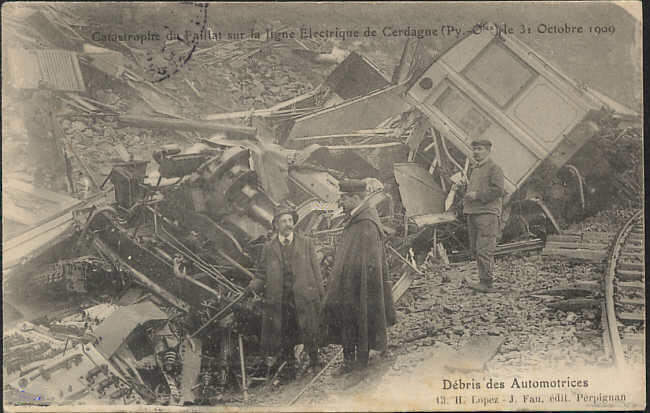
Poscard sent in 1913 Ed
Campistro Perpignan
(coll.
M.W.)
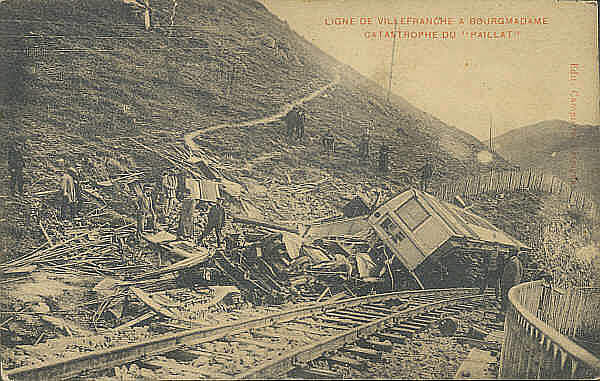
Photo on glass plate- (Arnodin
Fund)
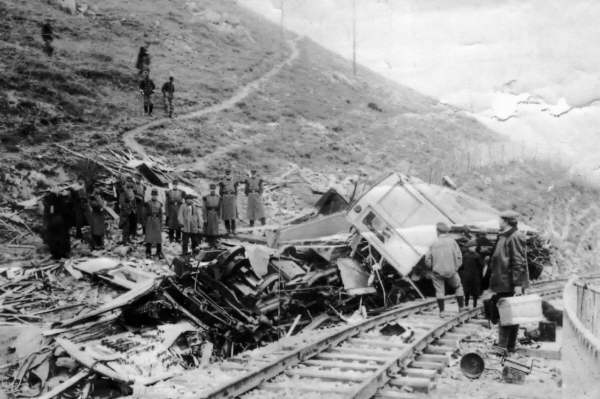
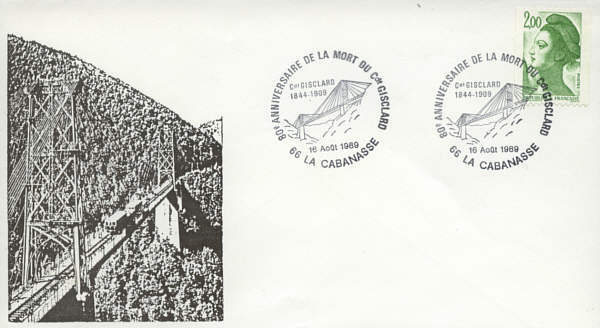
Envelope and
commemorative postmark published for the 80 th birthday of the death of
the Commander Gisclard
.
(Coll. M.W.)
Letter sent in
1962to Gaston Leinekugel Cocq, by Mr Lhériaud engineer of the drive hurt
in the accident, explaining him the exact causes of the disaster
(Sce Didier Leinekugel Le Cocq)
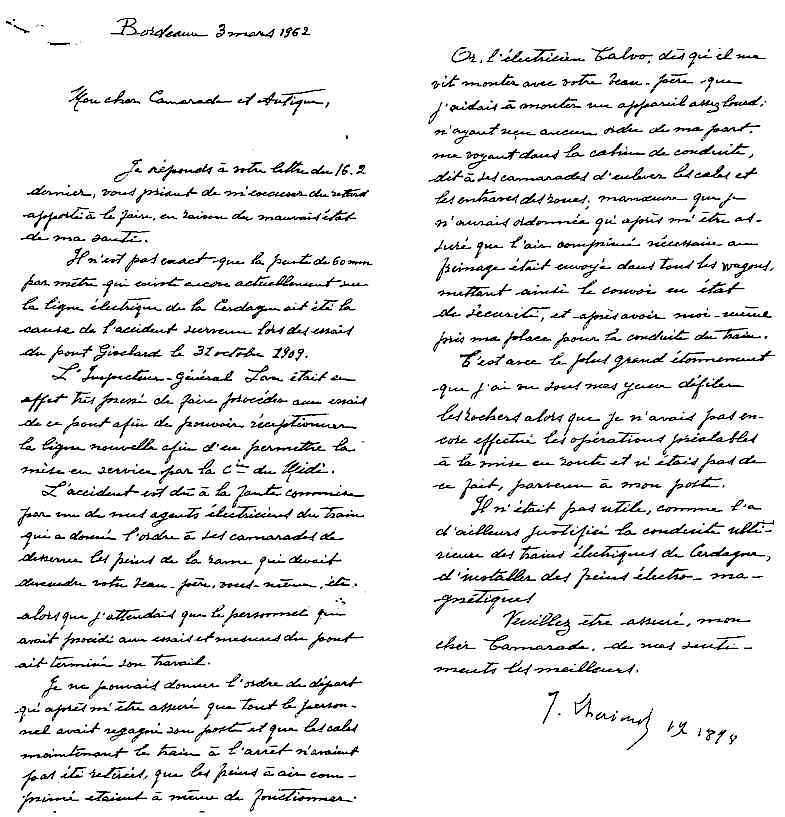
« …Il n’est pas exact que la pente de 60mm par
mètre qui existe encore actuellement sur la ligne électrique de la
Cerdagne ait été la cause de l’accident survenu lors des essais au pont
Gisclard, le 31 octobre1909.
L’Inspecteur général Lax était en effet très pressé de faire procéder
aux essais de ce pont afin de pouvoir réceptionner la ligne nouvelle
afin d’en permettre la mise en service par la C.ie du Midi.
L’accident est dû à la faute commise par un de mes agents électriciens
du train qui a donné l’ordre à sers camarades de desserrer les freins de
la rame qui devait descendre votre beau-père, vous-même, etc. alors que
j’attendais que le personnel qui avait procédé aux essais et mesures du
pont ait terminé son travail.
Je ne pouvais donner l’ordre de départ qu’après m’être assuré que tout
le personnel avait regagné son poste et que les cales maintenant le
train à l’arrêt n’avaient pas été retirées, que les freins à air
comprimé étaient à même de fonctionner.
Or l’électricien Calvo, dès qu’il me vit monter avec votre beau-père,
que j’aidais à monter un appareil assez lourd, n’ayant reçu aucun ordre
de ma part, me voyant dans la cabine de conduite dit à ses camarades
d’enlever les cales et les entraves des roues, manœuvre que je n’aurais
ordonnée qu’après m’être assuré que l’air comprimé, nécessaire au
freinage était envoyé dans tous les wagons, mettant ainsi le convoi en
état de sécurité, et après avoir moi-même pris ma place pour la conduite
du train.
C’est avec le plus grand étonnement que j’ai vu sous mes yeux défiler
les rochers, alors que je n’avais pas encore effectué les opérations
préalables à la mise en route, et n’étais pas de ce fait parvenu à mon
poste.
Il n’était pas utile, comme l’a d’ailleurs justifié la conduite
ultérieure des trains électriques de Cerdagne d’installer des freins
électro- magnétiques… »
(Just
After the disasyer -Photos on glass plate from the Arnodin'Fund
(Coll. D.Chénot)
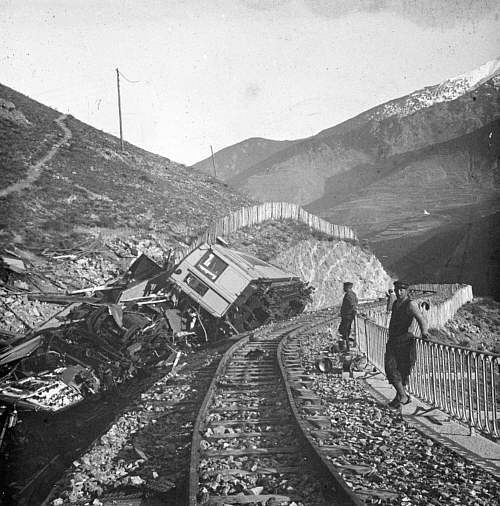
Ferdinand Arnodin looking at the debris of the train, and G. Leinekugel
Le Cocq, showing where he jumped off the train
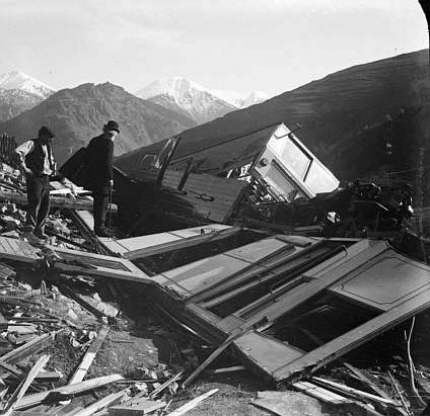
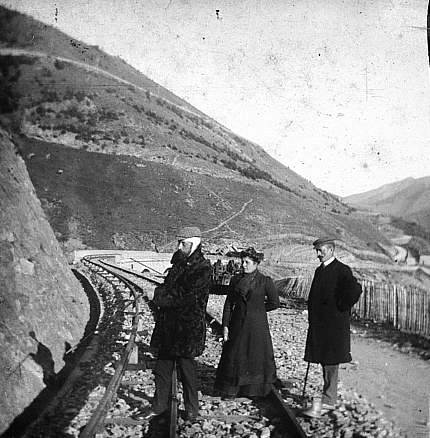
The official inauguration, envisaged on November 26,1909 was deferred to
July 18, 1911 .
Opening
of the bridge - Old postcards
(Coll. M.W.)-Ed Labouche
(Coll. M.W.)
Nb>>
These two cards
the first written and
sent on 23 March 2010,
were probably taken at the
start of official practice at
the end of which the
disaster took place
on October 31.
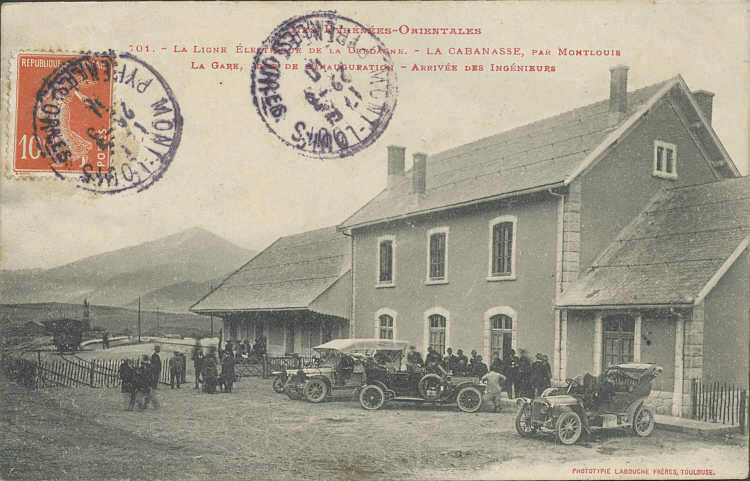
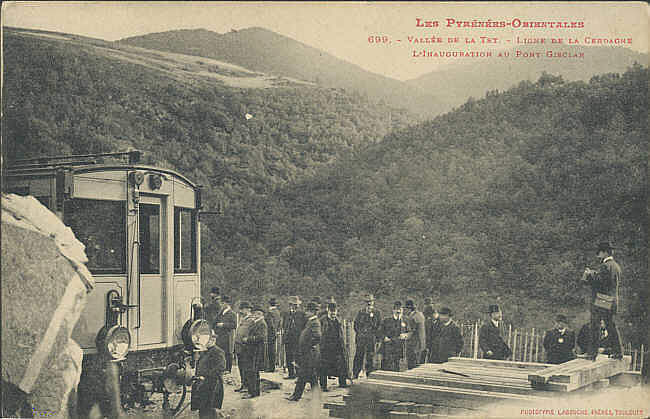
Les officiels au pont Gisclard-
The Officials on the bridge -
Photo on
glass plate from the Arnodin'Fund -Coll D.Chénot
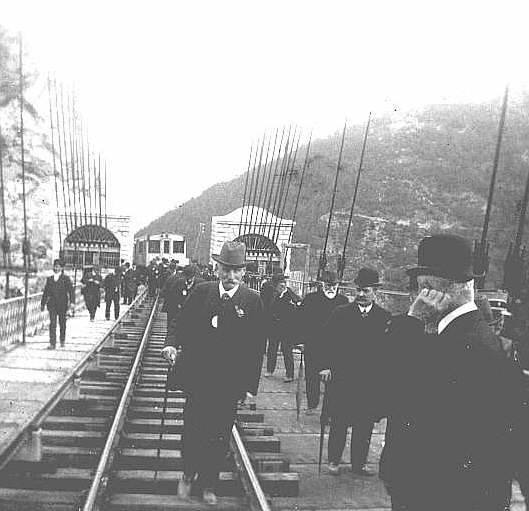
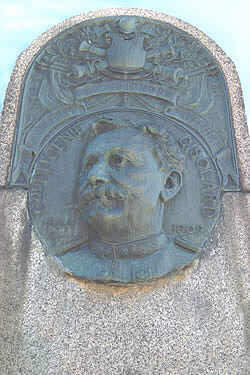
The stela
established on main road 116 overhanging the bridge was written as
follows:
With
The MEMORY OF
BORRALLO, CLERK TOULET, drivers of the Highways Departments
HUBERT, Section head of the State railways
BEZAULT, assembler Chief of the Arnodin company
Died in Service ordered with the Major GISCLARD
OCTOBER 31, 1909
Victims of the railway accident of Paillat
After the triumphal test of the Viaduct of Cassagne
CommanderAlbert Gisclard,
memorial stone, scuplture
from Jean
André Rixens
( Photo: Michel Castillo for the "Conseil Général des Pyrénées Orientales")
Stela dedicated to
Commander Gisclard - old postcard (Ed
L.Vergès)(coll.MW)
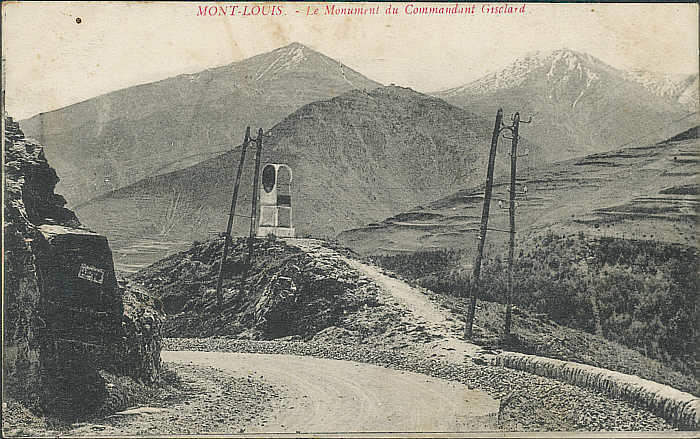
memorail stone , Poscard .Ed.Mar
(coll MW)
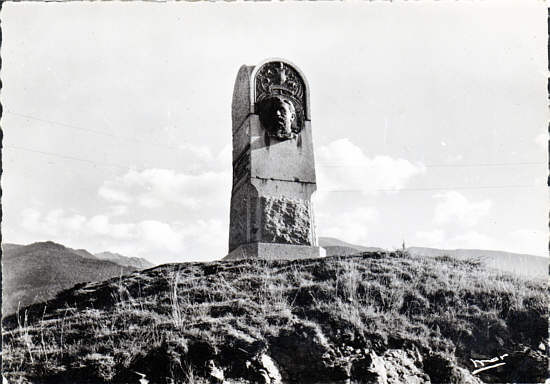
The Bridge was
classified historic building on April 29th of 1997, it is always in
service...
Modern postcard
(Iris Editions)
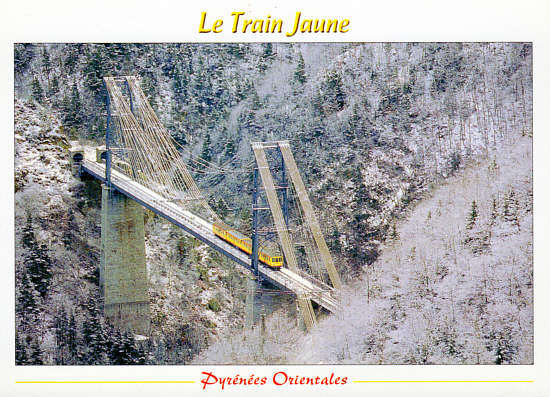
A stamp was issued in 2000, but showing another viaduct built by P.
Sejourné
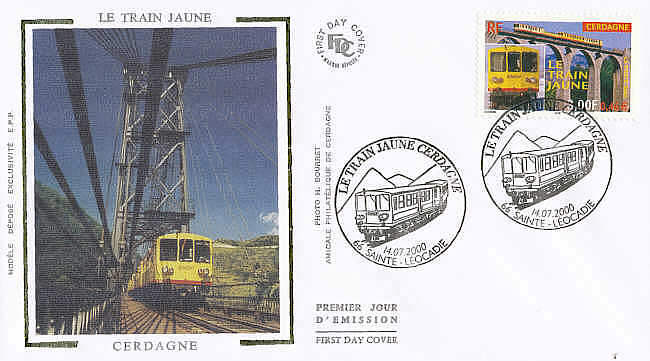
The bridge around 1960 - Poscard
Estel Edit.
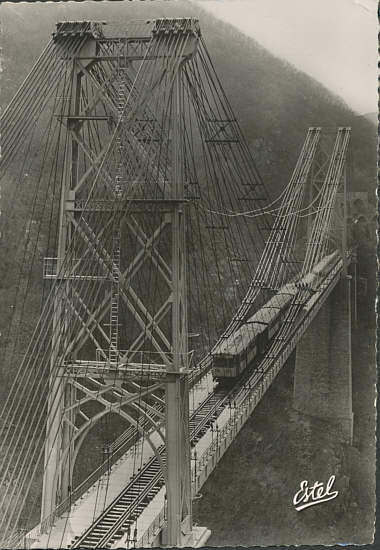
Photo L Chanteloup and Ed
Combier Macon
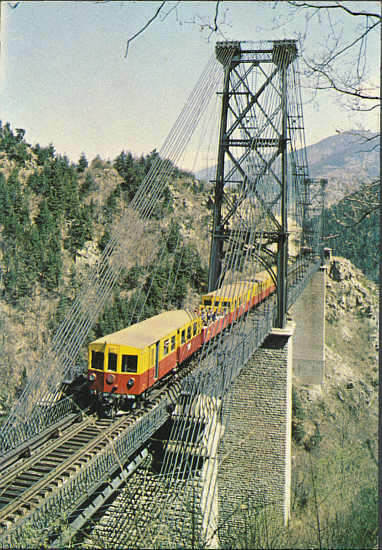
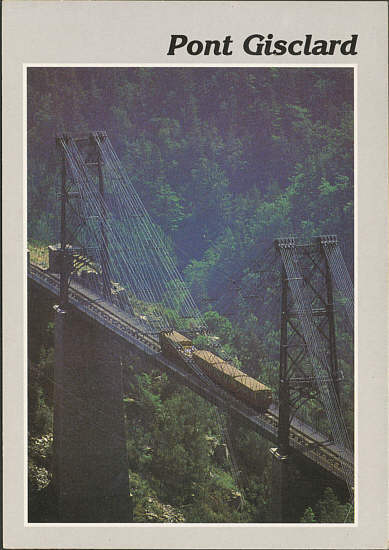
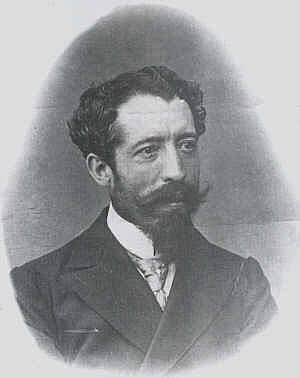 After
the catastrophe of the bridge of LaCassagne, it was
Gaston Leinekugel Cocq which took
again the continuation of work concerning the bridges of the Gisclard
type undertaken under Arnodin licence. In same time it wrote many
publications and deposited patents which improved the coùt and the
technicality of these works.
After
the catastrophe of the bridge of LaCassagne, it was
Gaston Leinekugel Cocq which took
again the continuation of work concerning the bridges of the Gisclard
type undertaken under Arnodin licence. In same time it wrote many
publications and deposited patents which improved the coùt and the
technicality of these works.
Gaston Leinekugel
Le Cocq
Picture from the
catalogue of the exhibition "de Fer et de Rêve"
(See also-
Ponts Transbordeurs)
In this way the bridge of Lapleau
still called "Viaduct of the Black Rocks" or "Viaduct de La
Roche-Taillade" was built by the "Arnodin company and associated"
between 1911 and 1913 for the line of the tram connecting Tulle to
Ussel.
Non adopted project
)
Postcard sent in 1909, before the construction of the bridge
(coll. MW) There is
to note that on this "elevation", the system of cable corresponds to
that of a traditional suspension bridge and not to the system imagined
by Gisclard and improved by G.Leinekugel Cocq
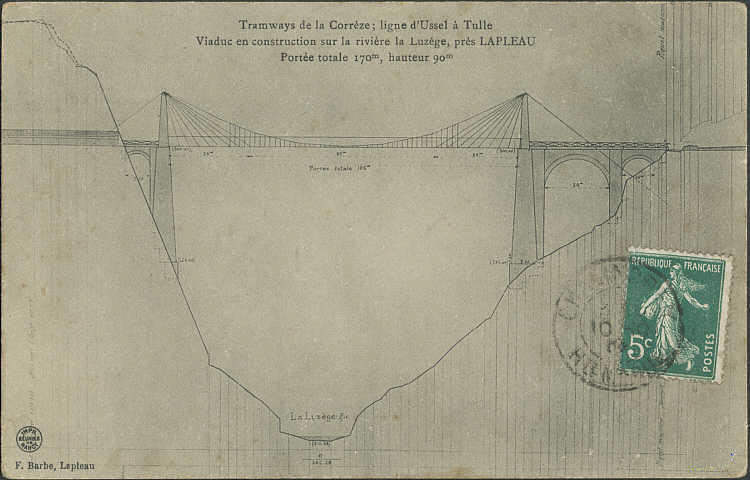
Bridge of Lapleau : Elevation (Sce
Magazine "Le génie Civil")
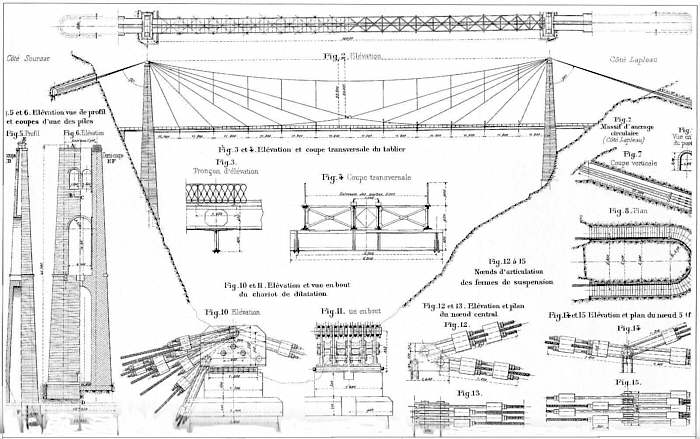
Construction
of
the bridge- old poscard
(phot. A.Vialle) (coll.MW)
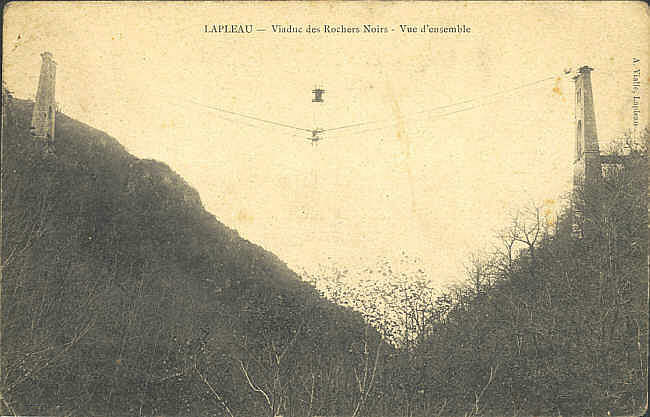
Photo from an article of" la Vie du Rail "de juillet 1980 and
postcard - J Mavier Photo
Edit.
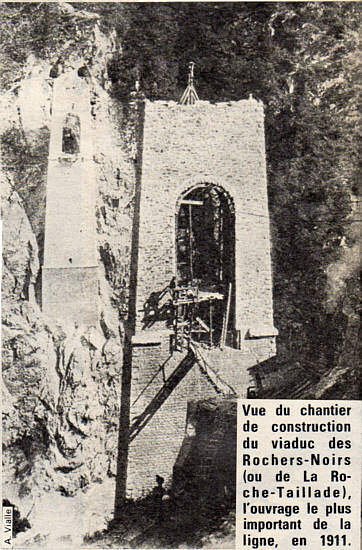
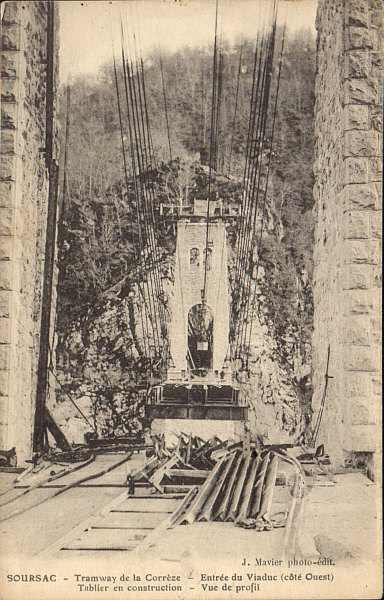
Building
the bridge, poscard sent in 1911(J.
Mavier phot Ed.)(coll.MW)
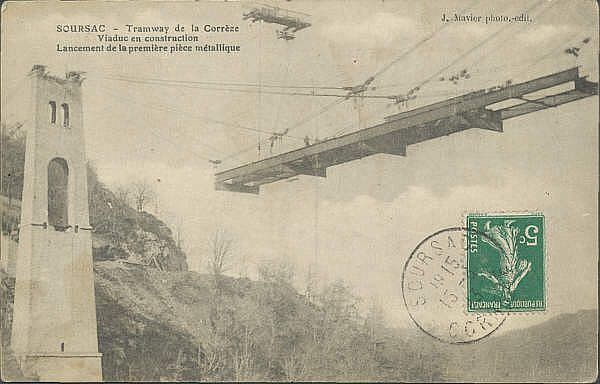
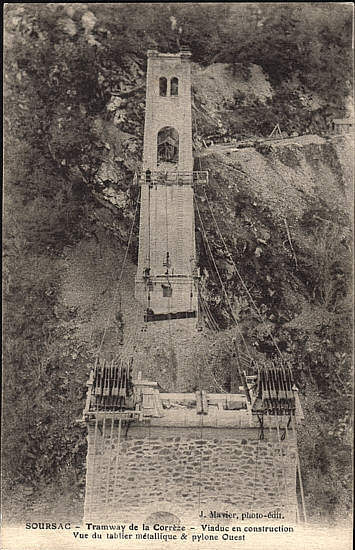
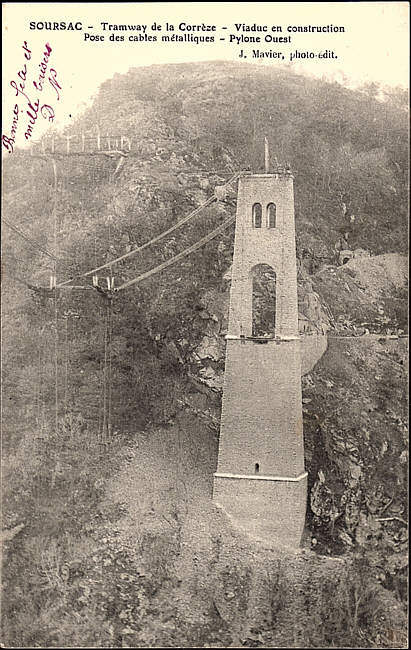
The bridge of Lapleau
was built according to a
process similar to that of
the bridge of La Cassagne,
by the company
Arnodin and associates
between 1911 and 1913
for the line of the tram
connecting Tulle
to Ussel.
It was inaugurated by the President of the Republic Raymond Pointcarré,
September 11, 1913. This viaduct crosses the valley of Luzège using a
140 m length span supported by two piles in masonry of 45 m, on an
overall length of 170m, 92 m with the top of the river. The line was
closed in 1959, the bridge was then transformed into road-bridge for
secondary road D89E until 1982. The bridge is classified today and
closed with any circulation, it is the only bridge of this type to have
preserved its aspect of origin.
Charging tests - Postcards (A.Vialle photo)
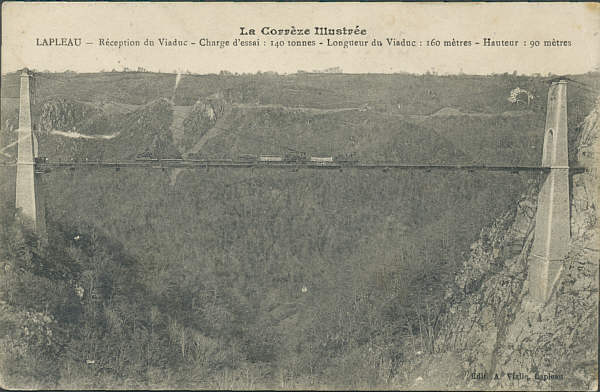

The presidential
train of the 11 09 1913 - Old postcard
(
coll MW)
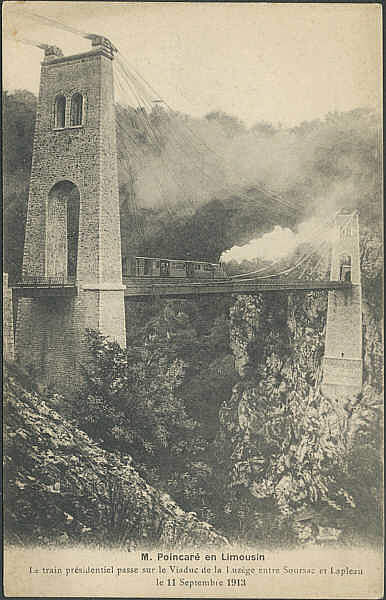
Old
postcards (Coll. M.W)
Suspension attachment system
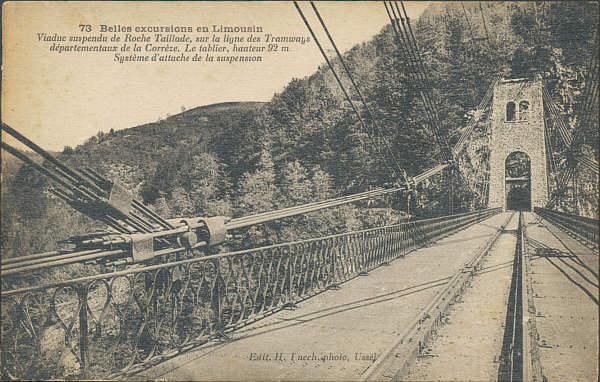
Postcard from 1916 (to note the presence of
2 workers on the cables, above, on the right)
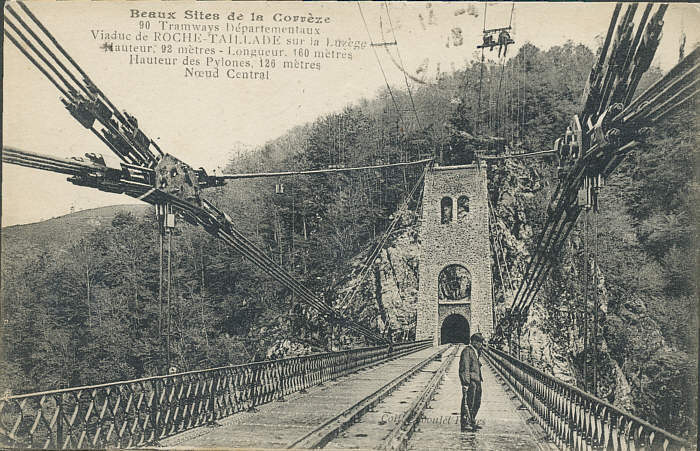
Both ends of the Viaduc
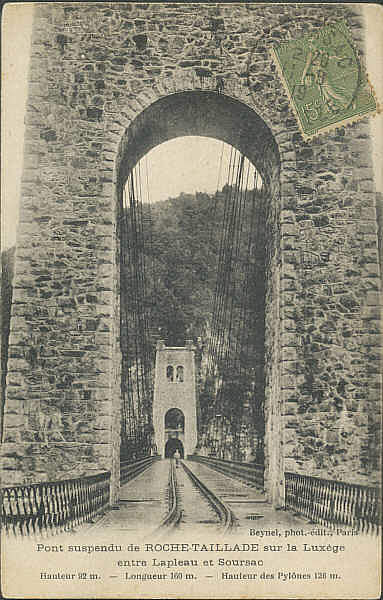
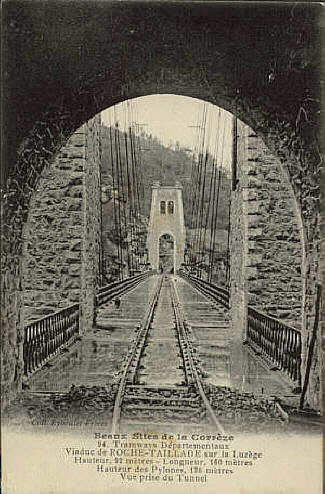
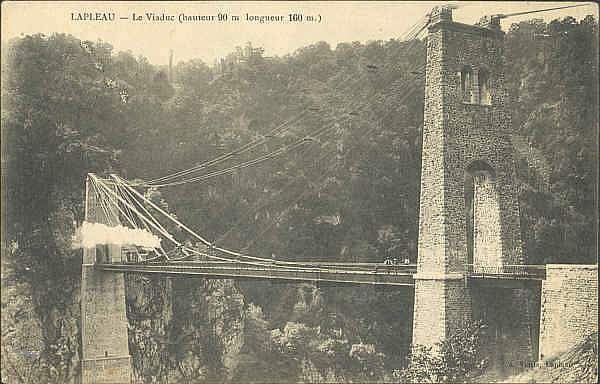
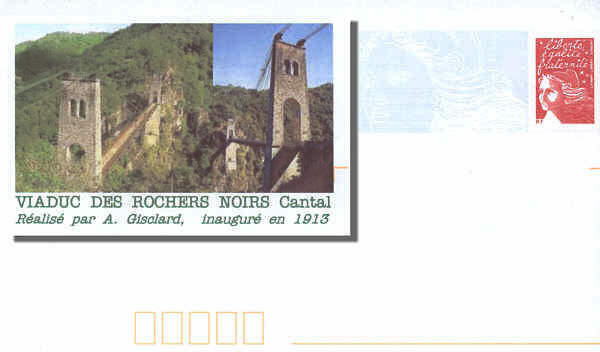
Postal
stationery (2004)?
NB - On this enveloppe is reproduced the erroneous
"Cantal" name whereas the viaduct is well located in Corrèze.
(error announced by Mr. Krempper)
Postal stationeries 2002 and 2005(Coll. M.W.)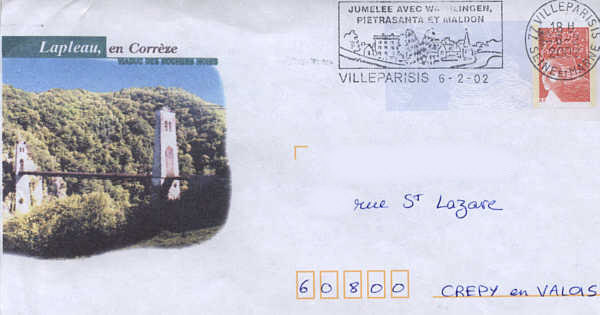
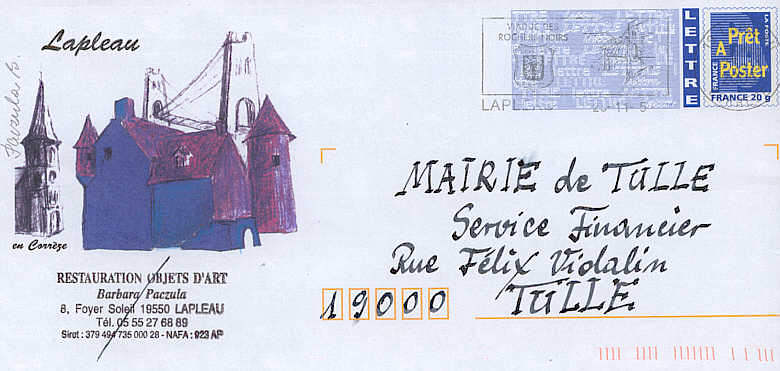 Cancellation- secap - 2005(Coll. M.W.)
Cancellation- secap - 2005(Coll. M.W.)
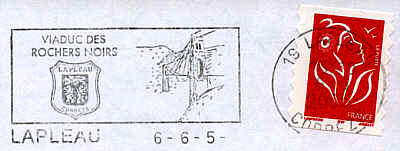
Stamp from "collector Limousin" (2012)
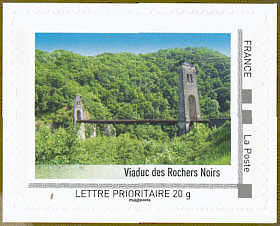
Old
postcard (Coll. M.W.)
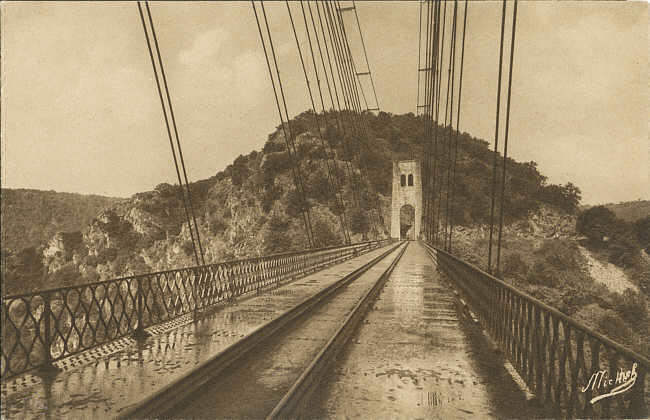
Modern postcard
from.1977 ( Photo Sully-Bort):
railway
disapeared.
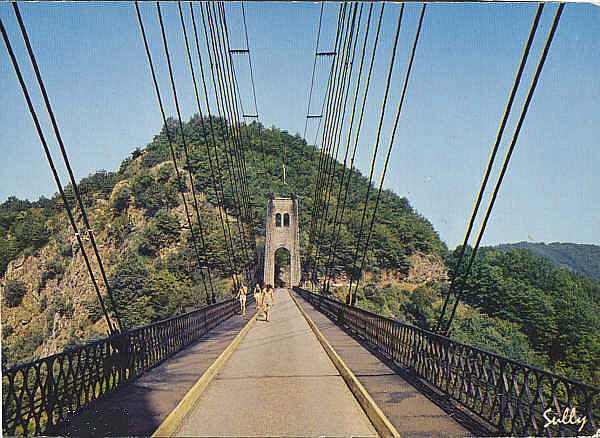
Autorail Billard on the viaduct des Rochers noirs
- Postcard (Photo Lepage - August 1959)
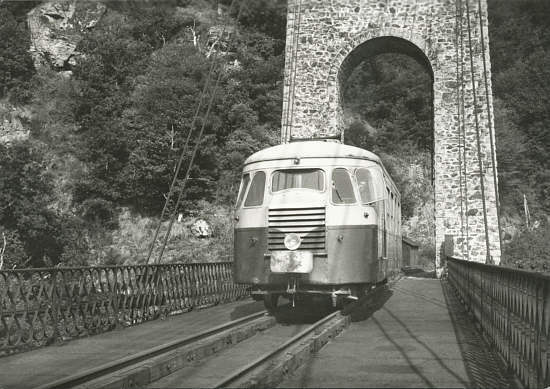
Cover of the magazine "La Vie du Rail" of
July 1980
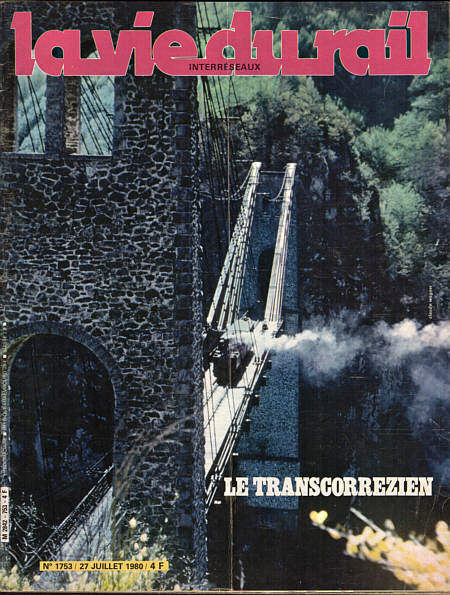
In 1913 also, another bridge was installed by
modifying a suspension bridge,
the bridge of Très Cassés
close to Castelsarrasin (Tarn and the Garonne.) Today
demolished it comprised 4 spans of approximately 61m each one,
supporting a railway and a road way. It was transformed thereafter into
bridge road.
Construction of the bridge
Photo on glass, from
" Arnodin'Fund"
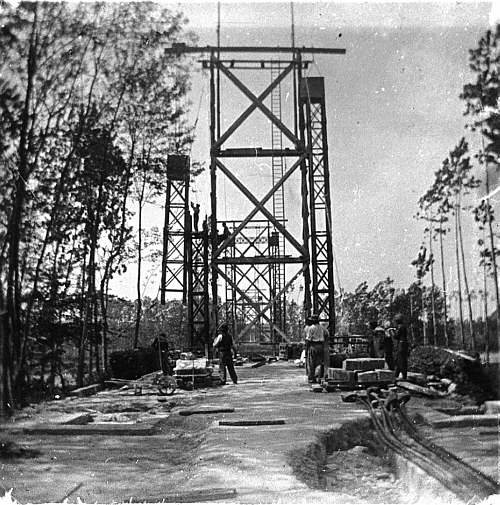
Technical drawings of the bridge by Arnodin(coll
MW)

Elevation of a
Pylon -
Epure of
Arnodin Workshops
(coll
MW) and Rey-A
Postcard -Ed
Castelsarrasin -
(1916
(This type of
pylon will be used for
many other bridges -Ed A Rey- Castelsarrazin
-(1916)
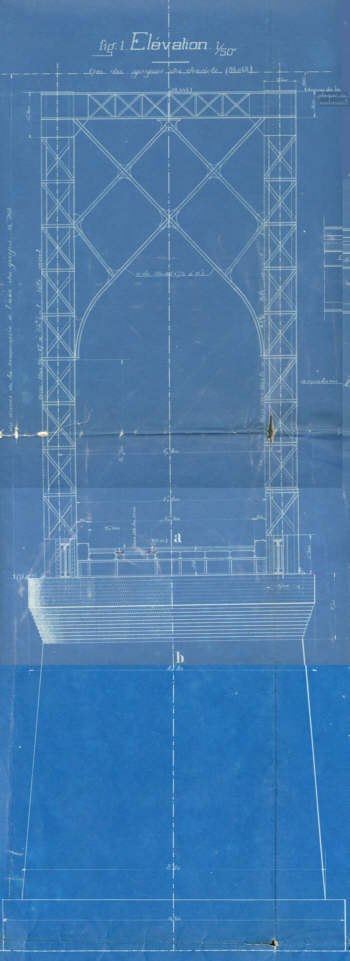

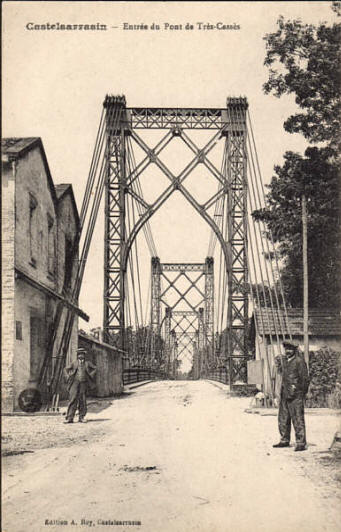
Old postards -
Labouche fr. Ed Toulouse
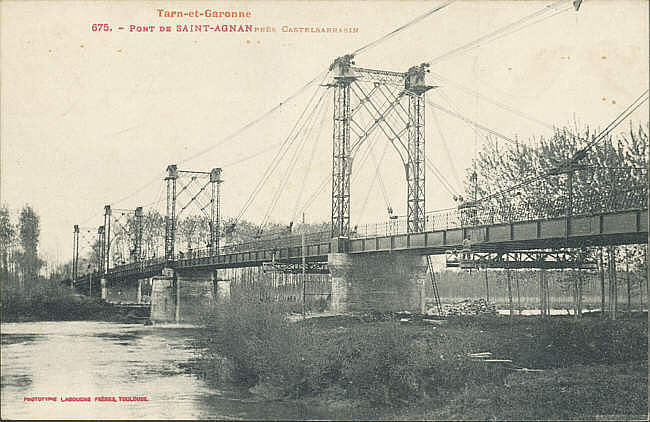
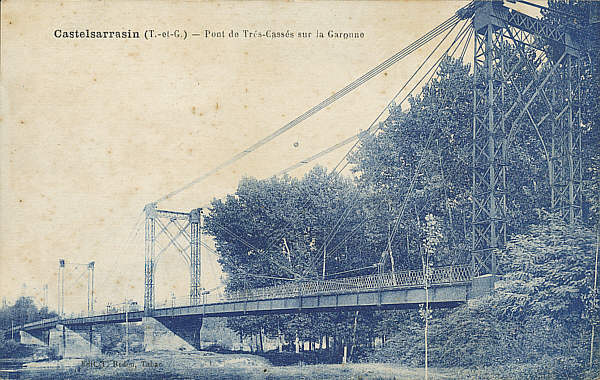
Ed Combier Macon et Photo E.Gilmt (1916)
MontaubanPostcard sent on
1916
- Photo E.Gilmt Montauban
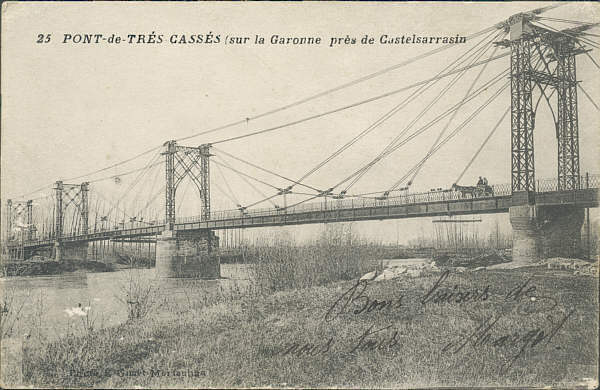
Postcard sent on 1922
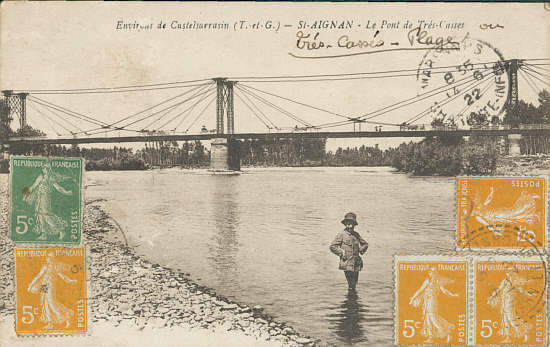
Postcard sent on
1961
Lapie Ed. St Maur
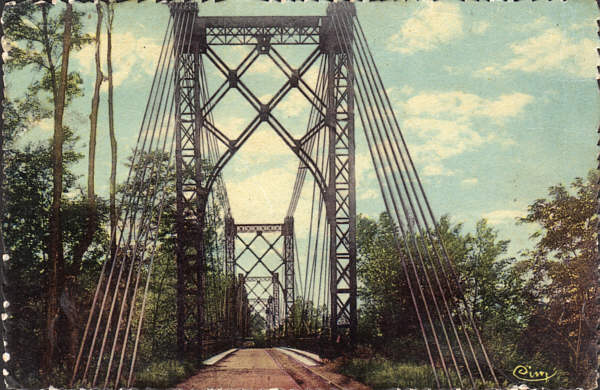
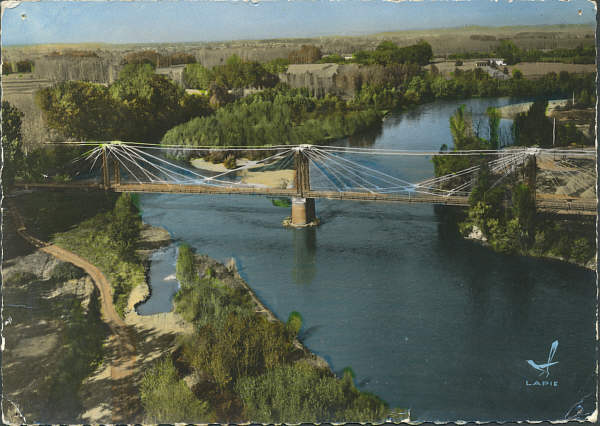
Pont de Très-Cassès
- Castelsarrasin - carte de 1955
Ed.Combier.
(Coll. M.W.)
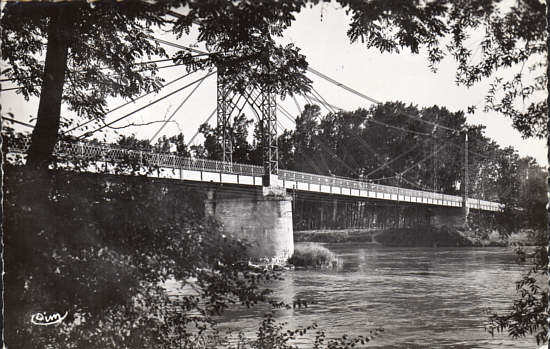
Between 1912 and 1914 is built another Gisclard bridge in Bourret in the same department of the Tarn and the Garonne , also to replace a bridge suspension built in 1842 and demolished in 1910. It acts of a bridge with three spans, of 69, 65 and 52 m supporting a railway and a road way. Transformed into bridge road after the closing of the railway line, it is classified today, and no allowed for all means of circulation...
Buiding
again the bridge, pictures on glass- Arnodin' fund
- Coll Chénot
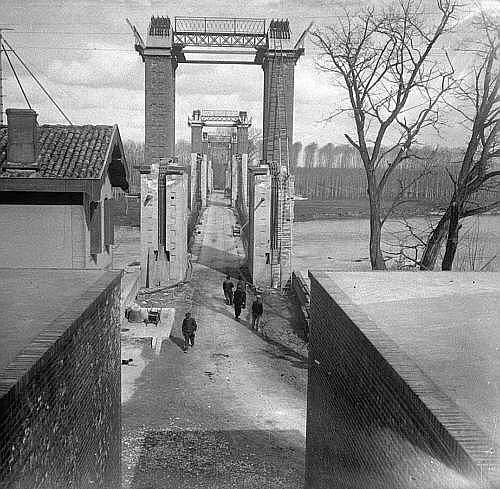
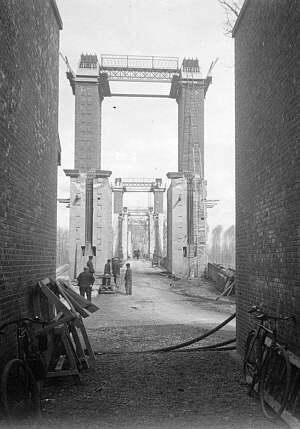
old poscard-
Bourret bridge nearly Montech(82)
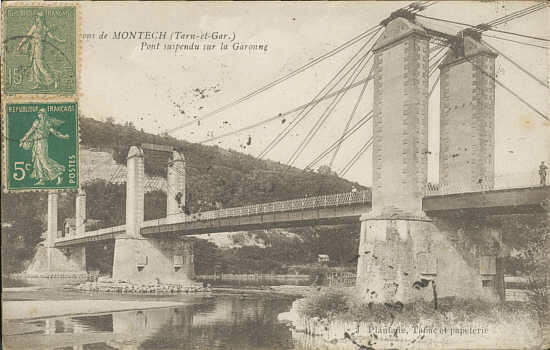
Postcard
S
Achille Bouis Phot.
Montauban
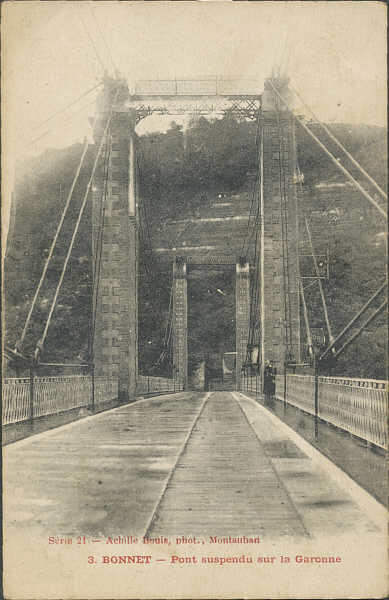
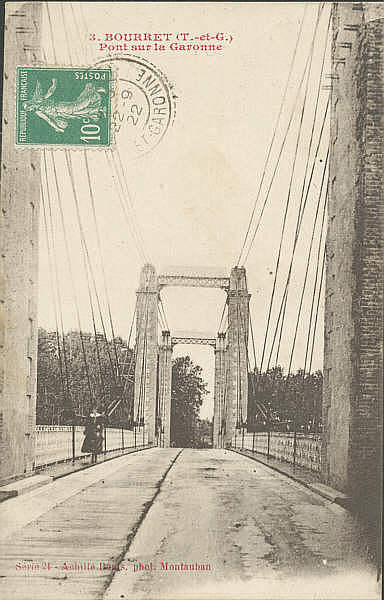
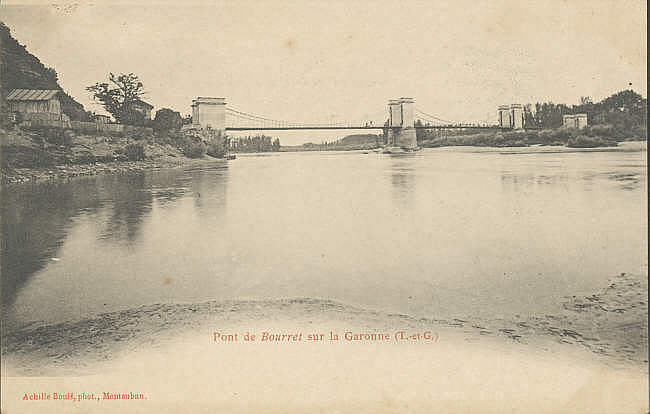
Bridge of Bourret
poscards
Ed Lapie St Maur
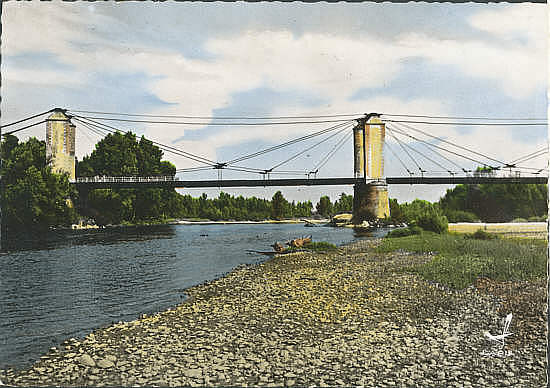
Ed Combier- Macon) (coll. MW)
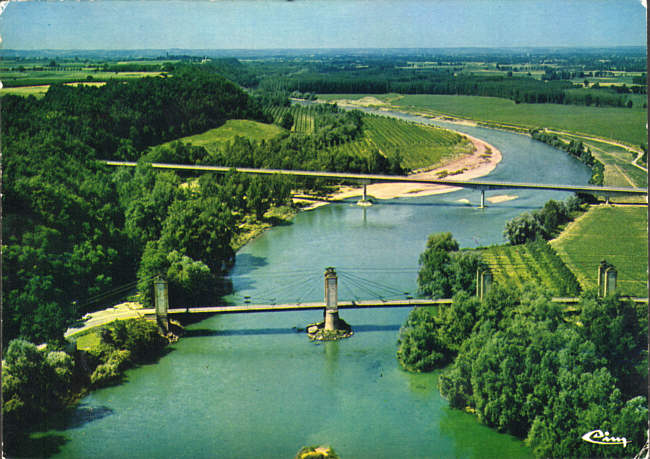
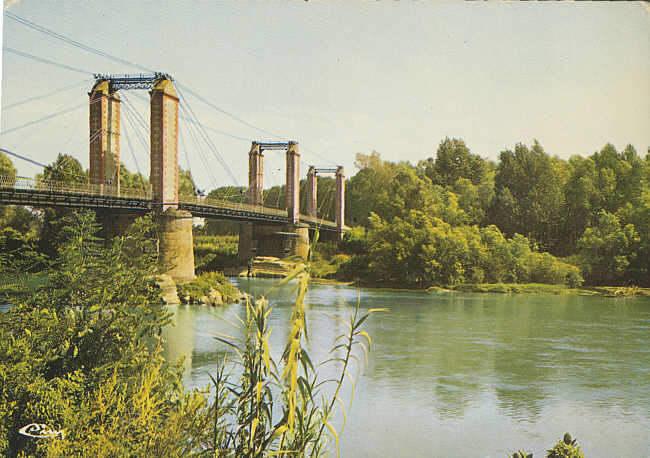
Bridga of Bourret ,
postal stationaries
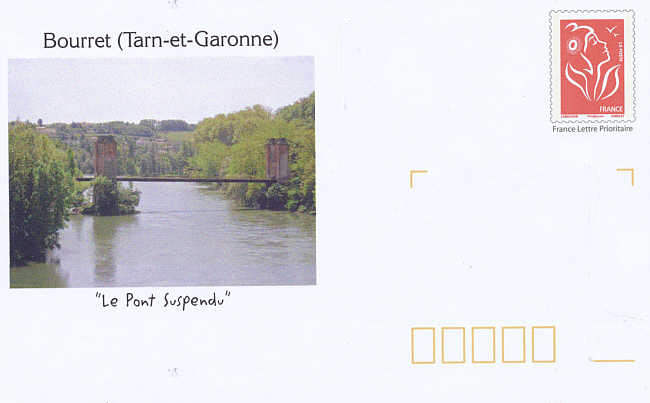
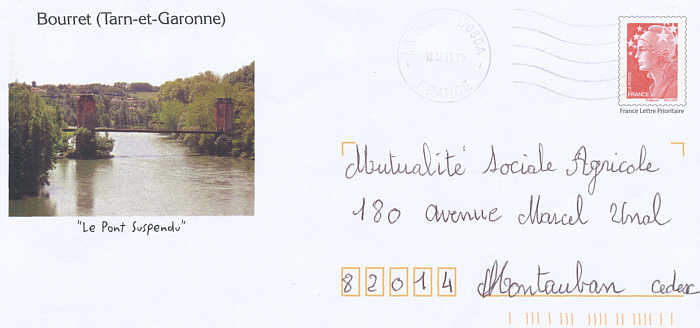
Two other bridges roads will be built in Morocco, on the road of Chari,
just at the time or will break up the 1st World War. This one will lead
to important evolutions in the construction of the suspension bridges
and that of the Gisclard bridges in particular.
Old postcard . Bridge at Mechra - Ben - Abbou_
Morocco
(Coll. M.W.)
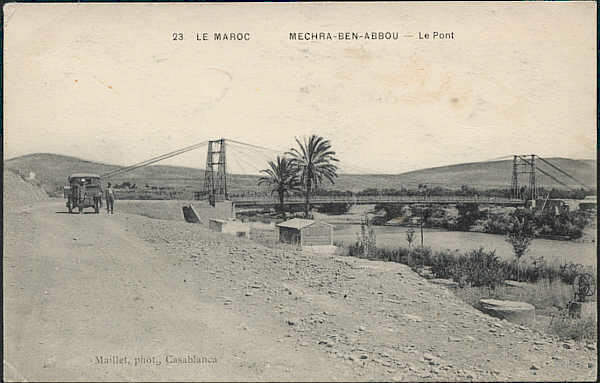
With the war of 1914-18, Gaston Leinekugel LeCocq, hitherto charged to
supervise the construction of the bridges of the Gisclard type is
mobilized and affected with the construction and the rebuilding of the
bridges to the back of the armies. Charged imagining and with setting up
a simple and effective method to install bridges of the Pigeaud type, it
will quickly develop a process of suspended footbridge intended to
facilitate the installation of these bridges whose 152 specimens will be
installed with its teams.
Construction of a bridge Pigeaud type by soldiers.
old postcard ( Coll. M.W.)
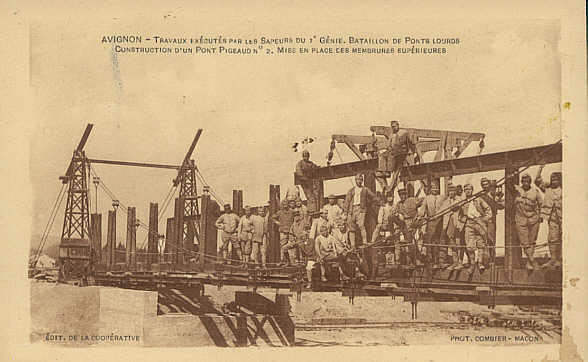
Photocards
(Coll MW)
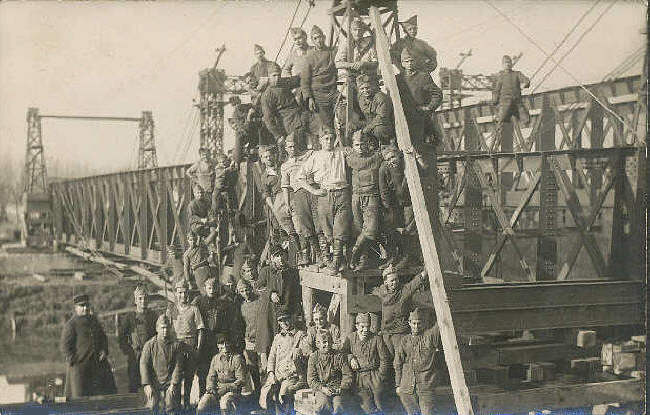
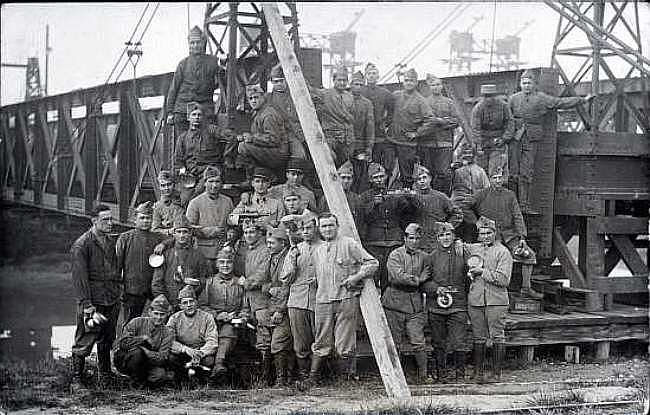
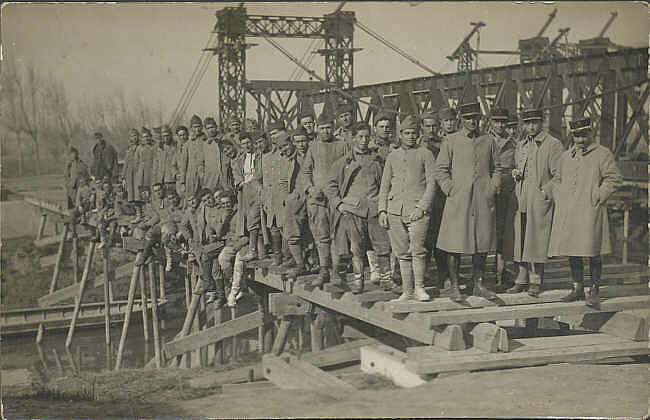
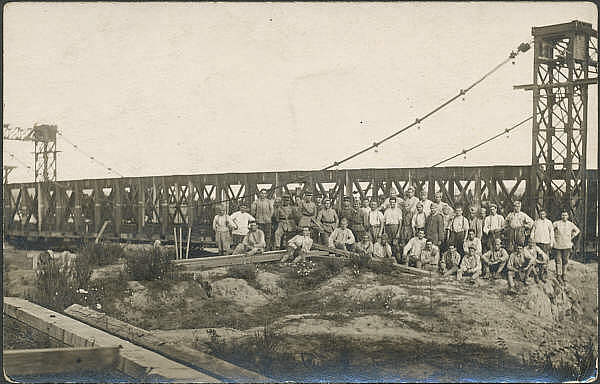
Photography- Coll
D.Leinekugel Le Cocq
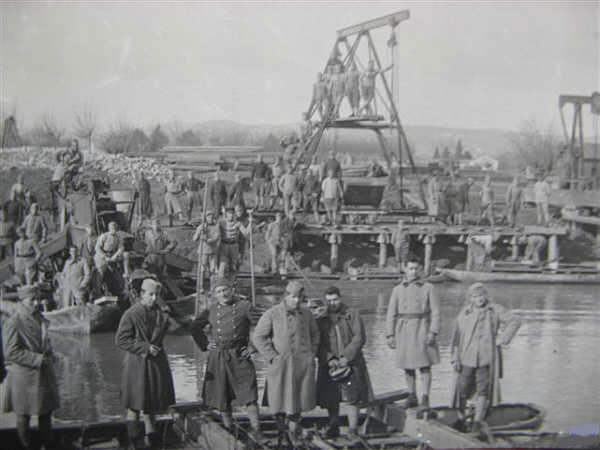
But the range of these bridges being
limited to 30 m, it proposes the use of the Gisclard process for the
construction of suspension bridges. Fifteen bridges of this type will be
thus built with the assistance of the workshops Arnodin .
Bridges construction in Châteauneuf -
Photographies on glass - Arnodin fund
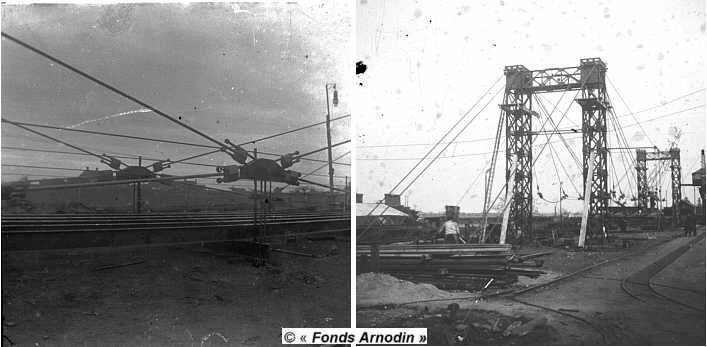
Gisclard' bridges
construction- old postcards
( Coll. M.W.)
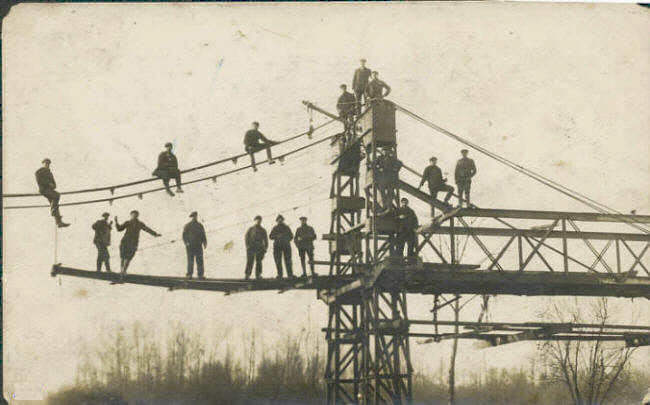
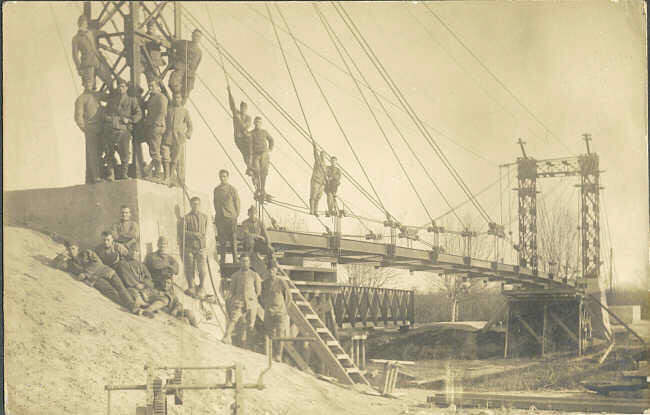
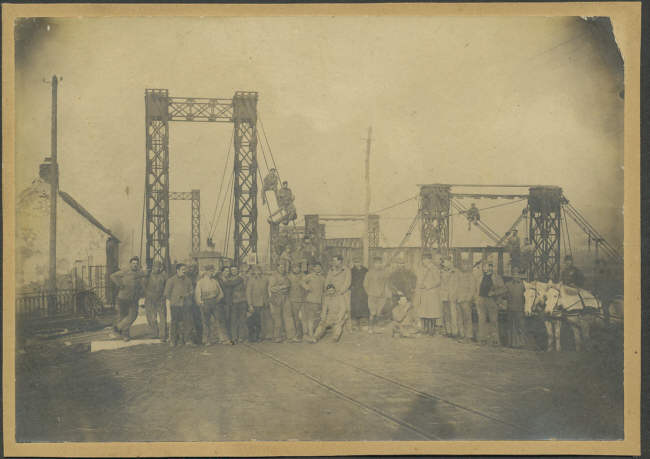
Photocard sent in 1907
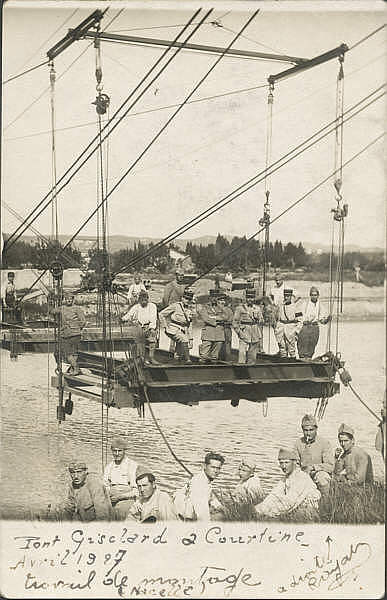
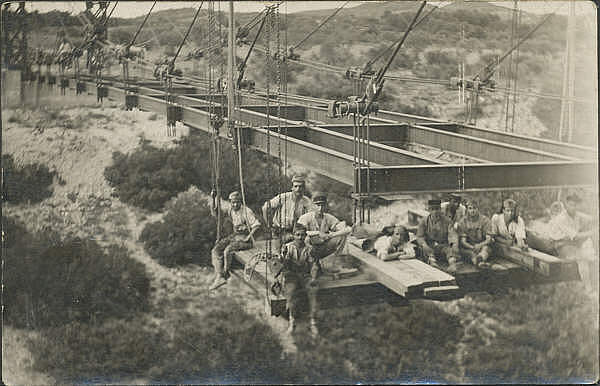
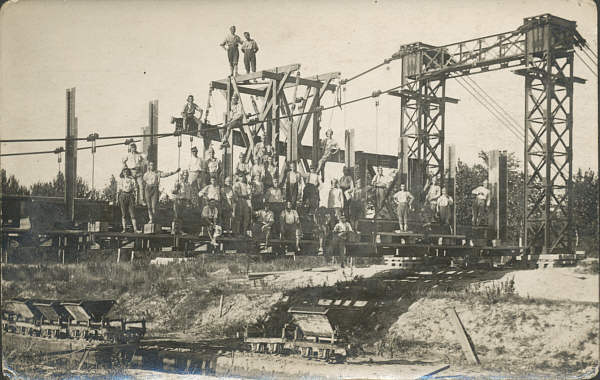
But the range of these bridges being
limited to 30 m, it proposes the use of the Gisclard process for the
construction of suspension bridges. Fifteen bridges of this type will be
thus built with the assistance of the workshops Arnodin .
Building Gisclard Bridge at Châteauneuf-
Photos on glass plates "FondsArnodin"

These bridges are in the order of construction:
Attichy
04/1915 --
Creil
(Oise - span 56m - 04/1915)
Jaux (Oise - span 82.30m- 02/1917)
Breuil/Vesle ( Marne - span
80m-03/1917)
Boran (Oise -span 70 m - 04/1918 )(see further)
Mareuil sur Ay (Marne -72.09m- 05 1918 )
Pont Ste Maxence (span 81.50 m -
05/18)
Verneuil ( span 70m - 08/1918)
Port à Binson
(span 75.50 m - 08/1918)
The first of them, the bridge of Attichy on Aisne with a span of 47.71m
Construction of the bridge- Picture from "Fonds Arnodin"
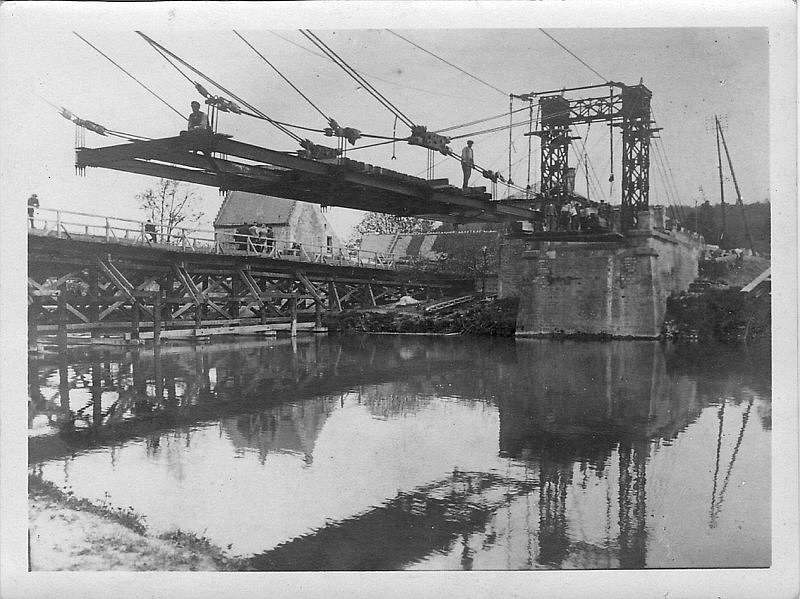
Photo cards "Association
for the Memory of Attichy
and it
Canton", with their kind
permission
and old postcard ( Ed. Bourson
-Compiegne)
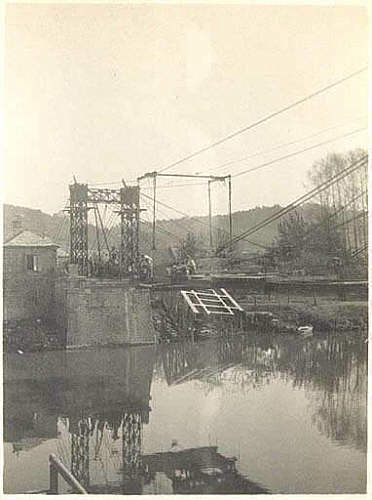
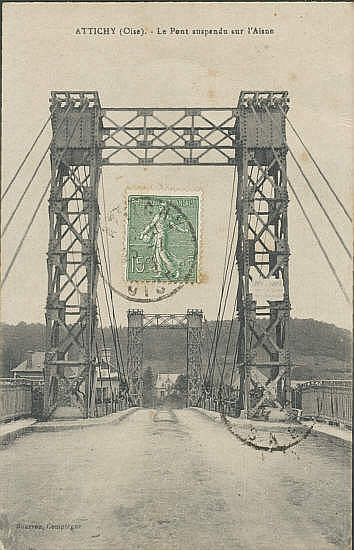
Attichy bridge- old postcards
(Coll. M.W.)
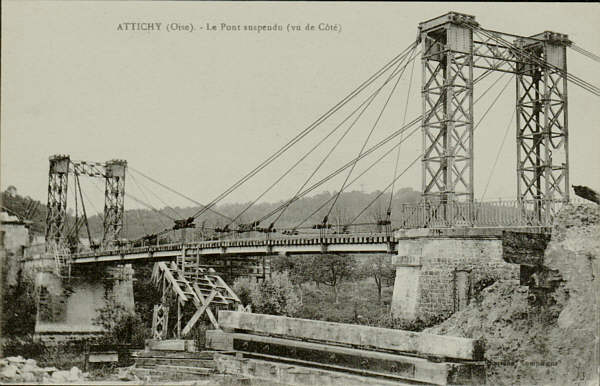
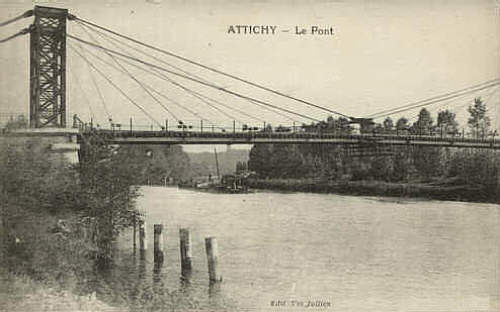
Attichy Photos...
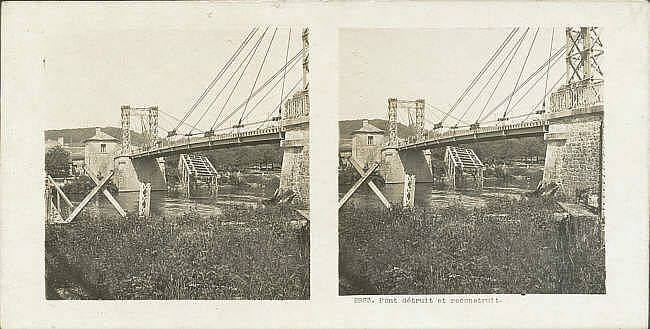
The second bridge, built in April 1915, the
bridge at Creil, replacing a bridge destroyed by the genie in
September 1914, will be the most photographed among all the bridges of
this type built during this period ...
old postcards
(Coll. M.W.)
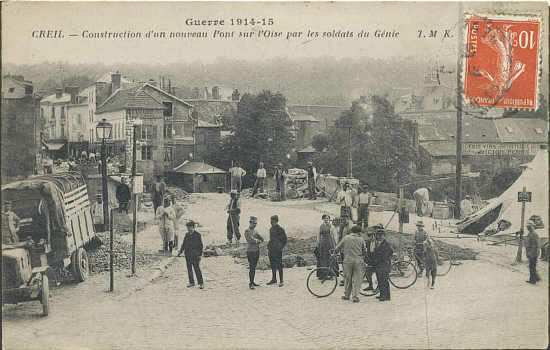
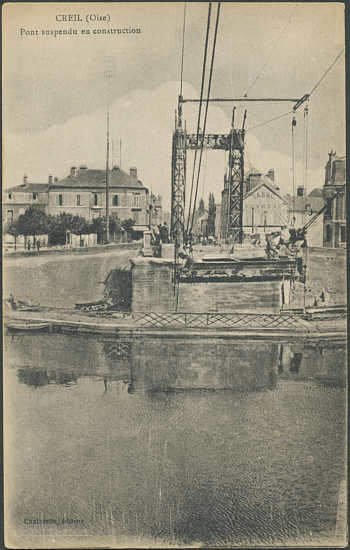
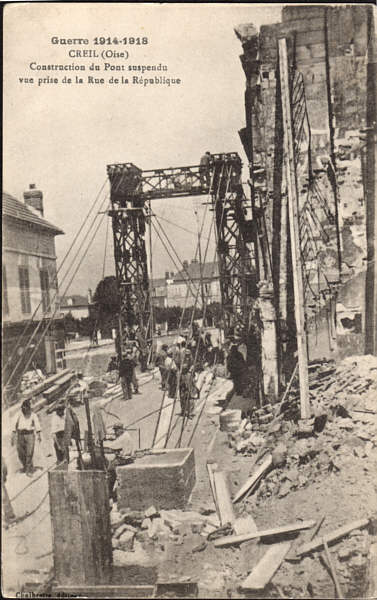
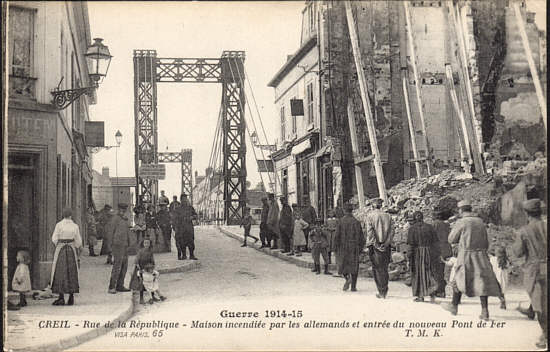
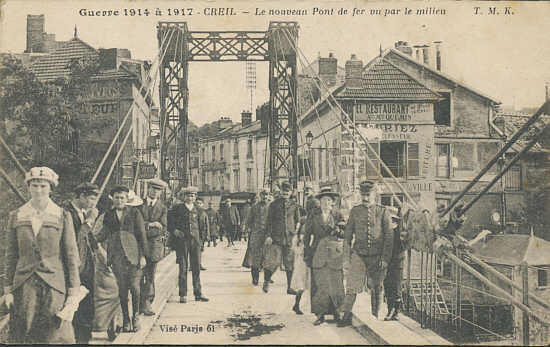
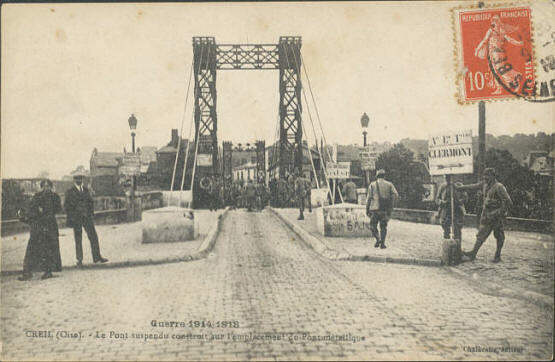
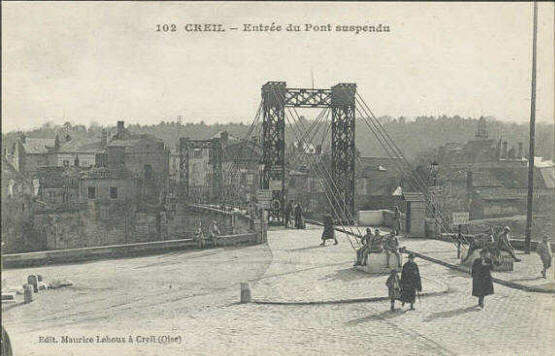
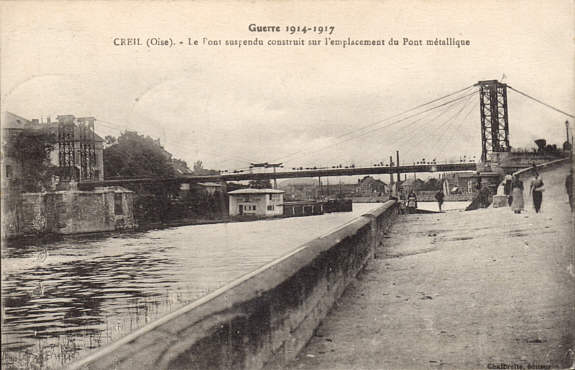
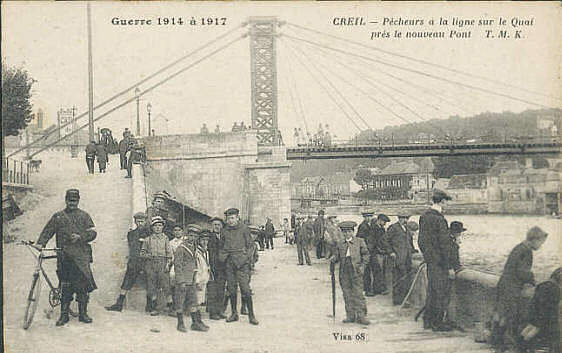
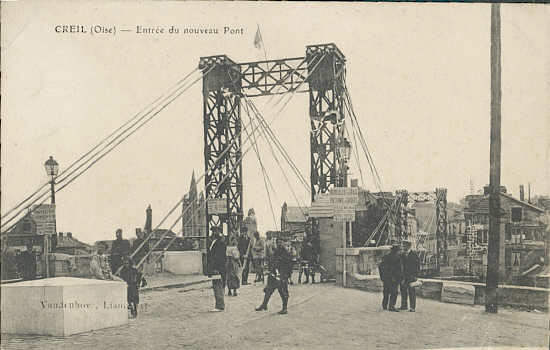
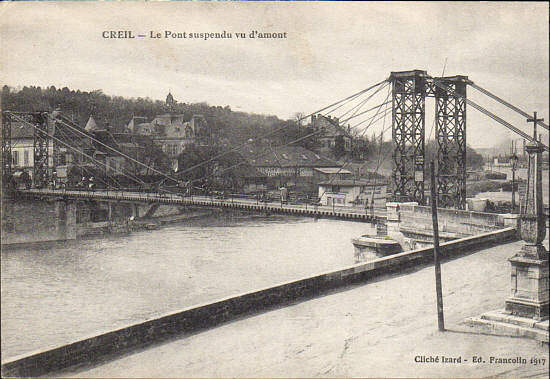
Old photography
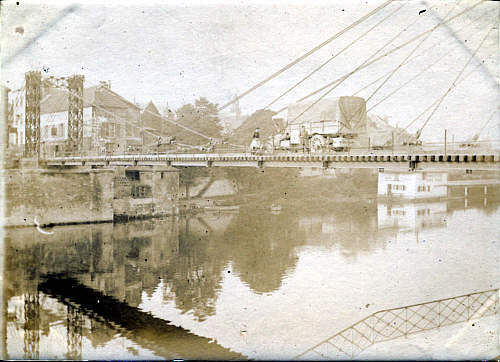
The Bridge at Jaux, is rebuilt in
february 1917
Picture
from 1917(Coll M.W.)
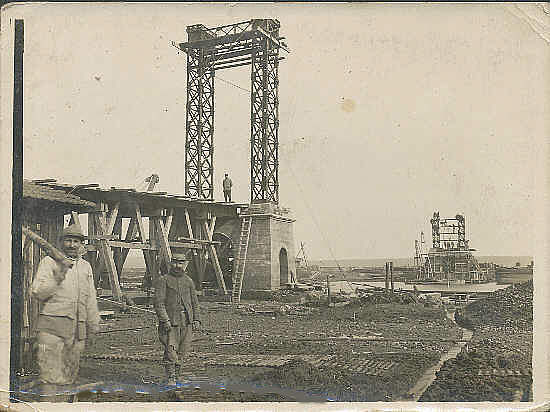
Postcard from
half of the XX century
(Ed Lapie)There
remains only the bridge
piers...
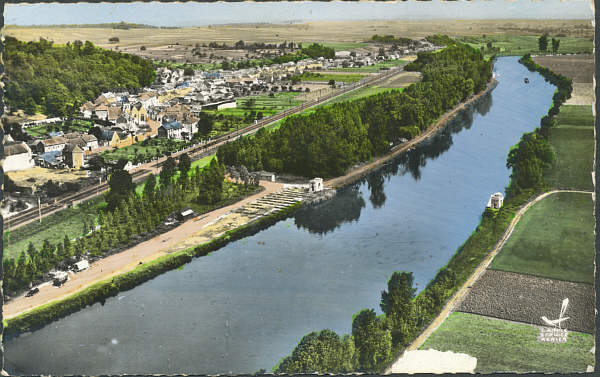
The bridge
actually, (Google
Earth pict.)
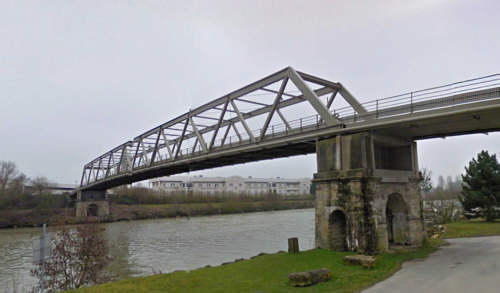
In
April 1918 the
Boran
Bridge(Oise) was built
to replace a bridge built
in 1841, destroyed
by the Corps in 1914.
The first version of the eventfull history of this bridge after 1914,
had a roadway made up of three elements assembled Pigeaud kind held by a
simplified Gisclard' system.
The bridge at Boran destroyed- Original
painting on post card
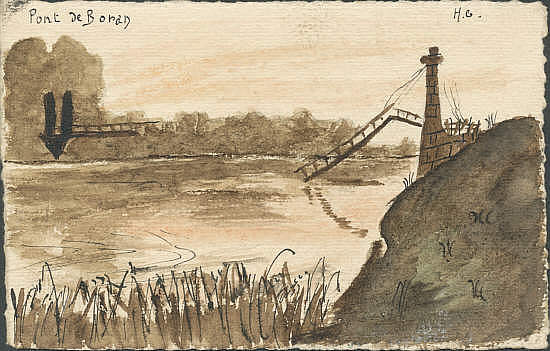
This bridge was rebuilt in
1927 (see
part 2)
The bridge of Boran,
old postcard( Coll M.W.)
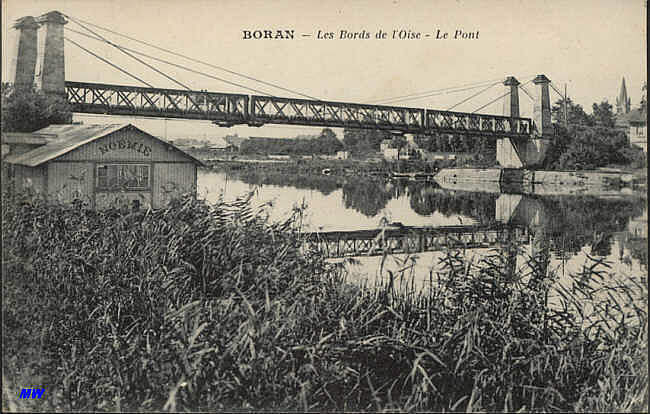
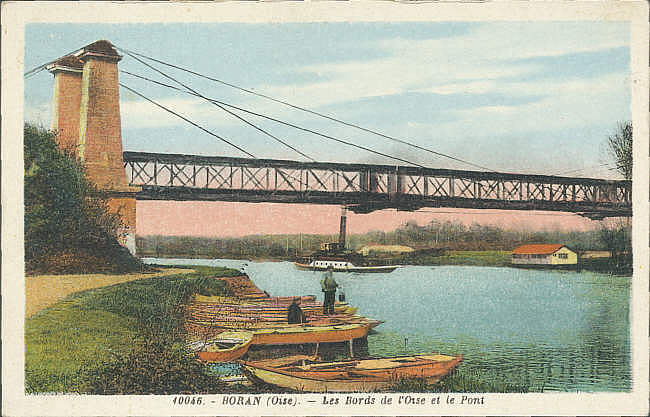
1917 March, reconstruction of the bridge at
Breuil sur Vesle-
Marne
The
bridge reconstruction in Mareuil
sur Ay was completed
in May 1918 with
a simplified suspension
system. A wooden bridge
built in 1915 to
facilitate the transport of
troops will remain for
some time in parallel.
postcard-
Phot. G.Franjou Ay
(Coll M.W.)
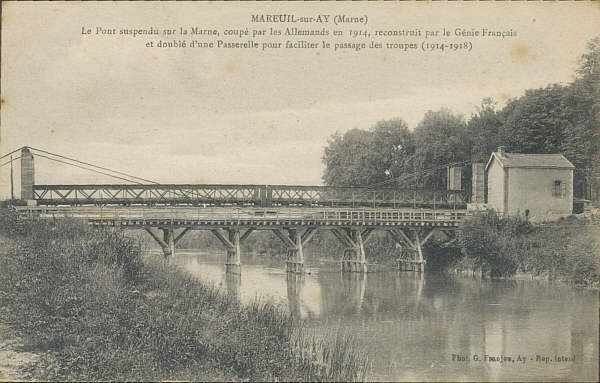
postcard sent in 1921- V.
Thuillier Ed. Epernay
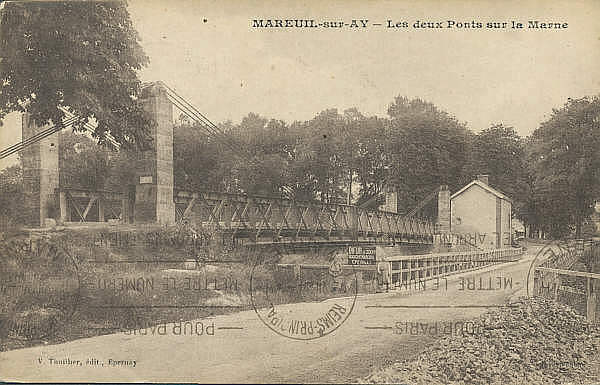
The bridge of
Ste Maxence, Oise, will remain only
16 years, re - blown up to slow down the enemy at the beginning of the
2nd World War, as its predecessor, the wonderful bridge,
built by Perronet in 1785,
destroyed in september 1914.
postcards from 1919
and 1923 (Coll. M.W.)
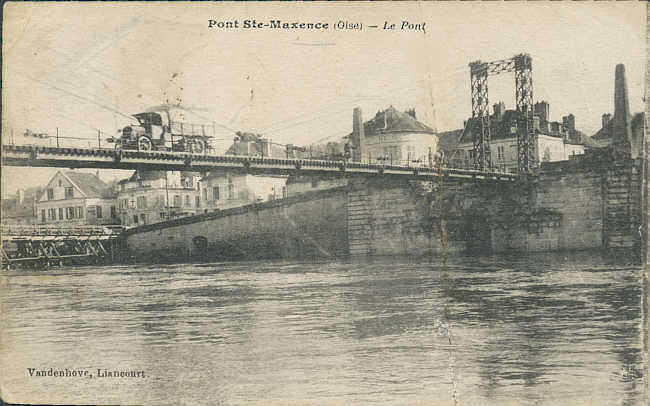
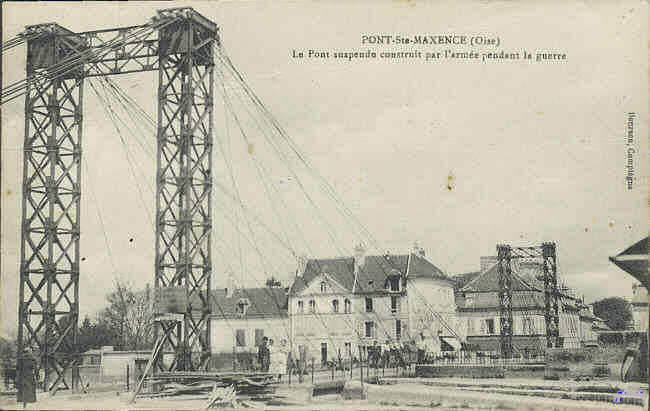
Bridge at Port-à-Binson
,of 75.50m
span was built in
August 1918 to replace a
suspension bridge destroyed
in 1914
The bridge before
the war water colour on card
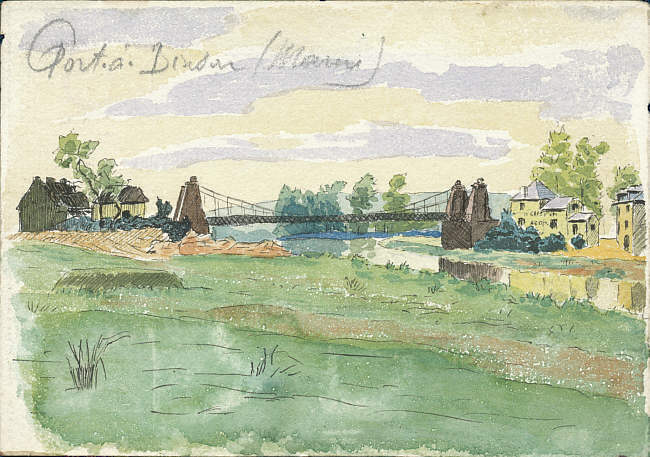
Bridge at Port à
Binson - postcards, from 1928
(Coll. M.W.)
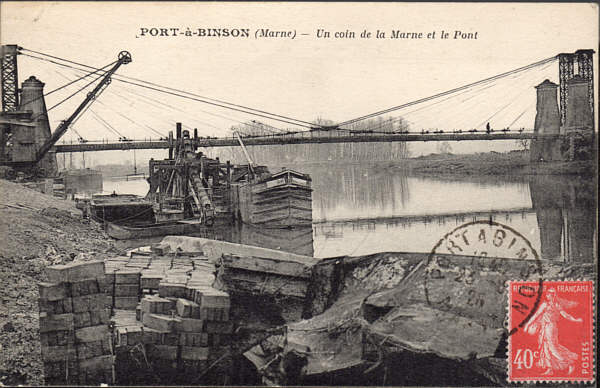
Bridge at Port à
Binson - old postcards
(Coll. M.W.)
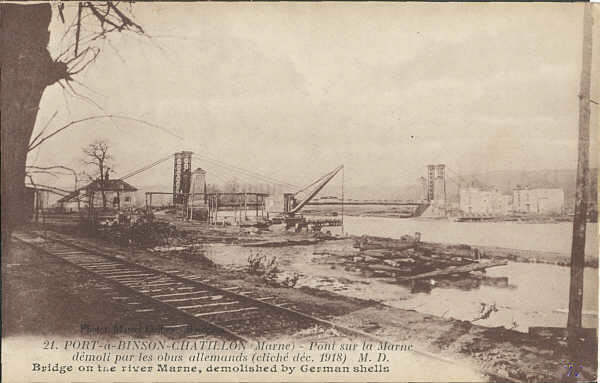
Re-building of the bridge at Port-à-Binson
Old postcard/spictures sent
between october and december1918 by a whitness to her family.
(Coll. M.W.)
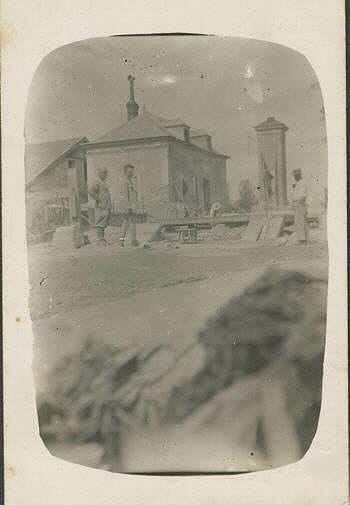
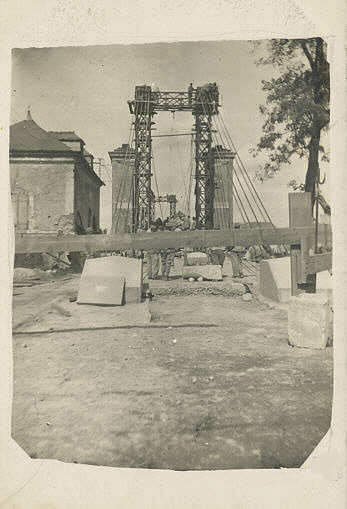
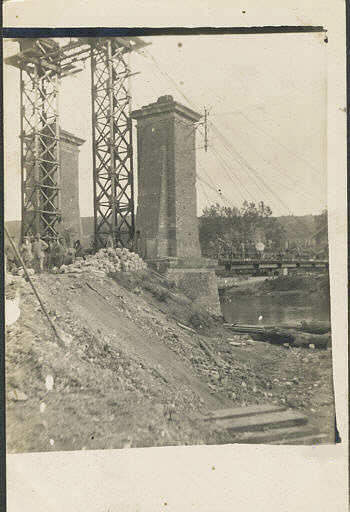
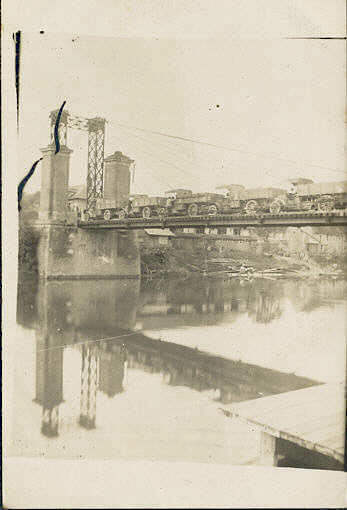
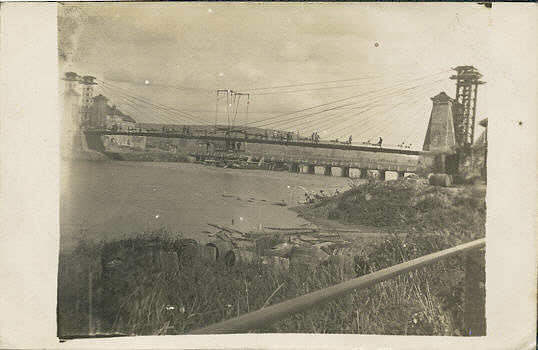
...